fall inside a hole
Early Plarail Hikaris (1964-1979)
First written September 1, 2023Expanded May 11, 2024
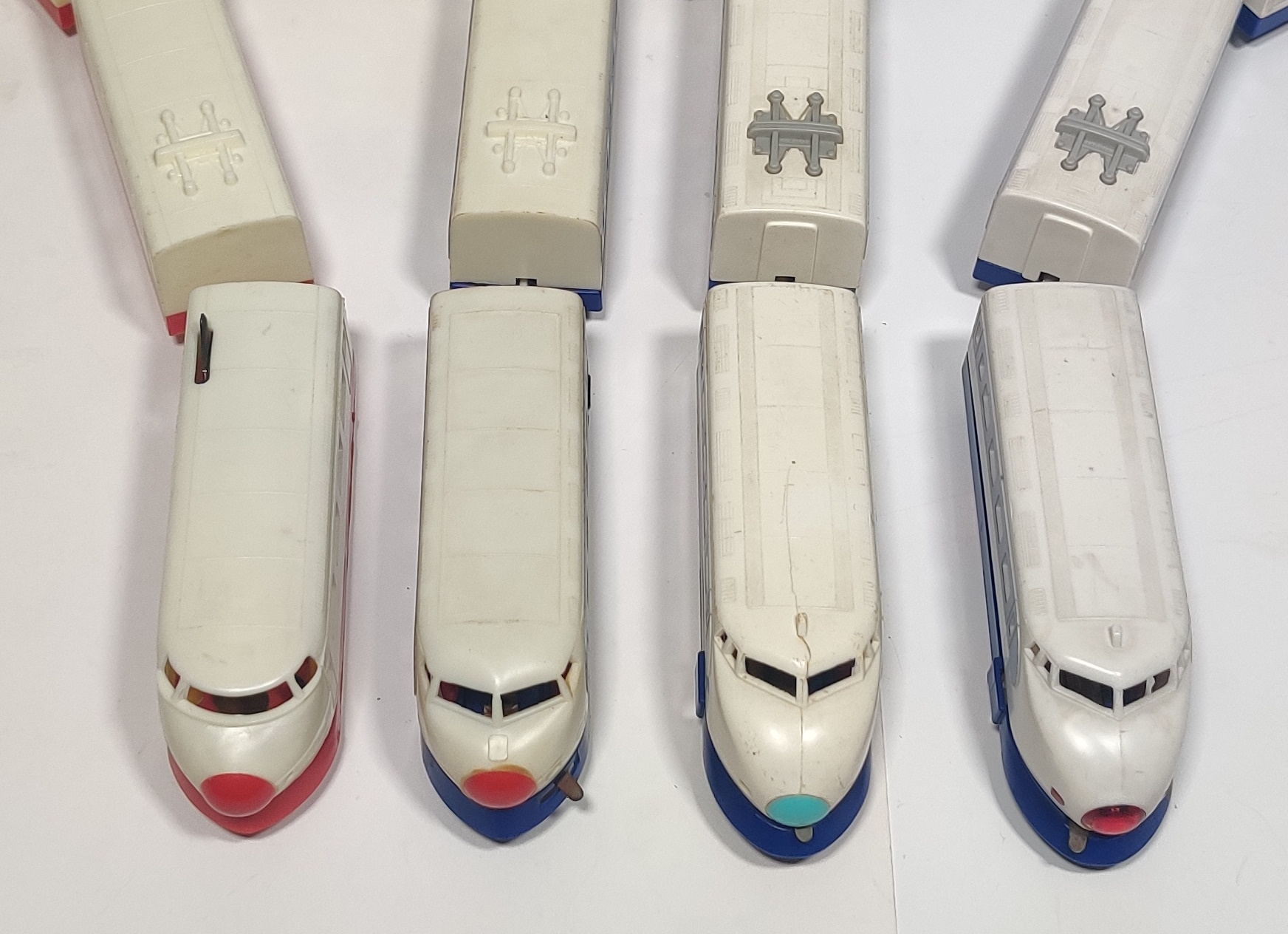
The first Shinkansen line opened in October 1964 and was serviced by what would eventually become known as the 0-series Shinkansen but was often referred to at the time as the Shinkansen or the Hikari. The Hikari was the faster of the two services running on the Tokaido Shinkansen line when it opened (the slower "kodoma" service was also run by 0 series trains, but these services stopped at more stations). Classic bullet-nosed 0 series trains would exclusively service the line for the next two decades before 100 series trains came into operation in the mid 1980s with more new trains coming in the 1990s. The last 0 series trainsets in service remained pulling some trains on the Sanyo Shinkansen line into 2008.
Tomy released their first Plarail Shinkansens, both a powered and unpowered train, in 1964. Early Plarail Hikaris used a white body shell like the real trains but with red skirting instead of blue and without the blue stripe around the windows. I have seen one early piece of apparent Shinkansen concept art which did have a red skirting but it appears Tomy surveyed or had seen at some point a later 1000-series prototype that as far as I know was shown off in white and blue, and it seems to be a perplexing question both to children at the time and to collectors now as to why Tomy went with this design. Perhaps they felt that this made the train distinct enough to avoid any legal problems, although many decades later Plarail 0 series trains would wear real Japanese Railways marks. According to the box for the Shinkansen 60th Anniversary Commemoration 0 Series Shinkansen Hikari 1 & Super Express Hikari Set, which references these old red and white trains, says that it was because it was a popular color with children at the time.
Plastic Dream Super Express (1964)
In 1964 a four-car push train with a front, tail, and two intermediate cars representing the 0 series shinkansen were released as the Plastic Dream Express (プラスチック夢の超特急). These were in the style of earlier Plarail Plastic Trains and were unpowered. These trains remained on sale into the later 1960s, but are hard to find nowadays.
Electric Super Express Hikari-go Set (1964)
The first version of the Electric Super Express Hikari-go Set (電動超特急ひかり号セット) has a front-mounted power switch in the bodywork of the power car as opposed to the chassis of later versions and metal hook and eye couplings. A boxed example of this version of the train can be seen in the Plarail Museum. A comparison of most of these types of Hikari can be found in the Biglobe Plarail Museum.
This older molding of the 0-series Shinkansen is actually based on the 1000-series prototype Shinkanens as it has a different front window support system and the windows in the doors are square rather than thinner rectangles. Additionally, the 0 series was first represented with a red skirting and nose, while the 0 series actually ran with a blue chassis and rim around the windows with a white body for the first few decades it was in service. One early concept I have seen for the Shinkansen has some red skirting, but by the time of the bullet-nose shape and 1000-series prototype the trains had blue skirting and window-surrounding streak.
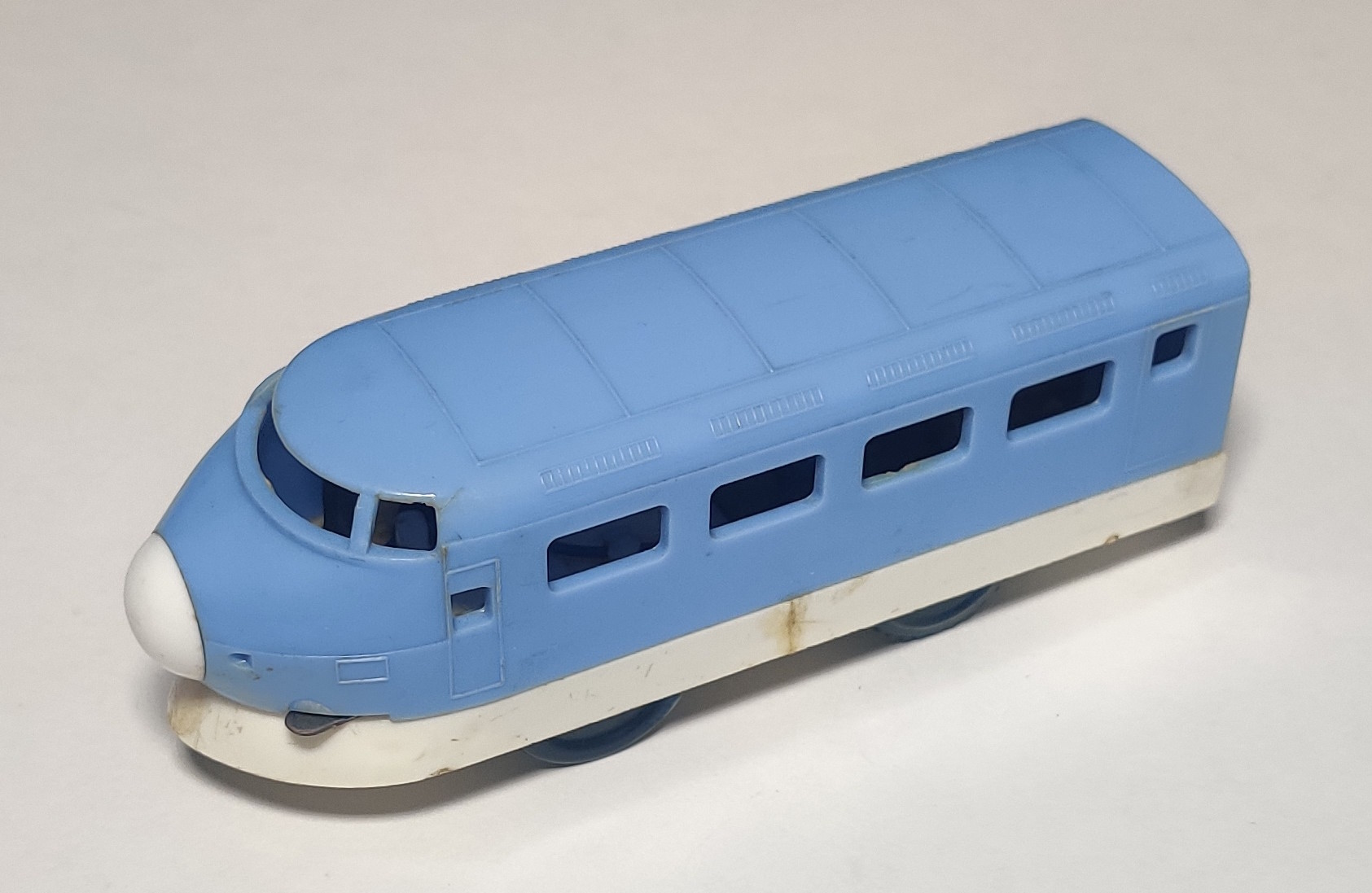
Although I do not currently own an original issue Super Express Hikari, I do have the light blue with white chassis version of the power car exported for use in some Child Guidance sets.
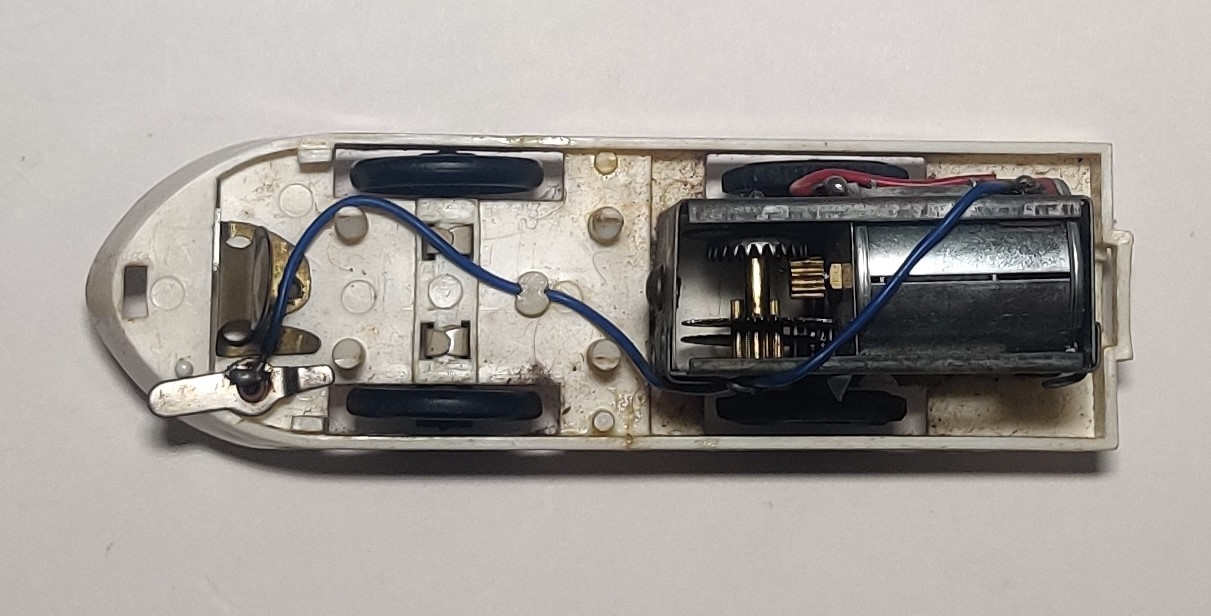
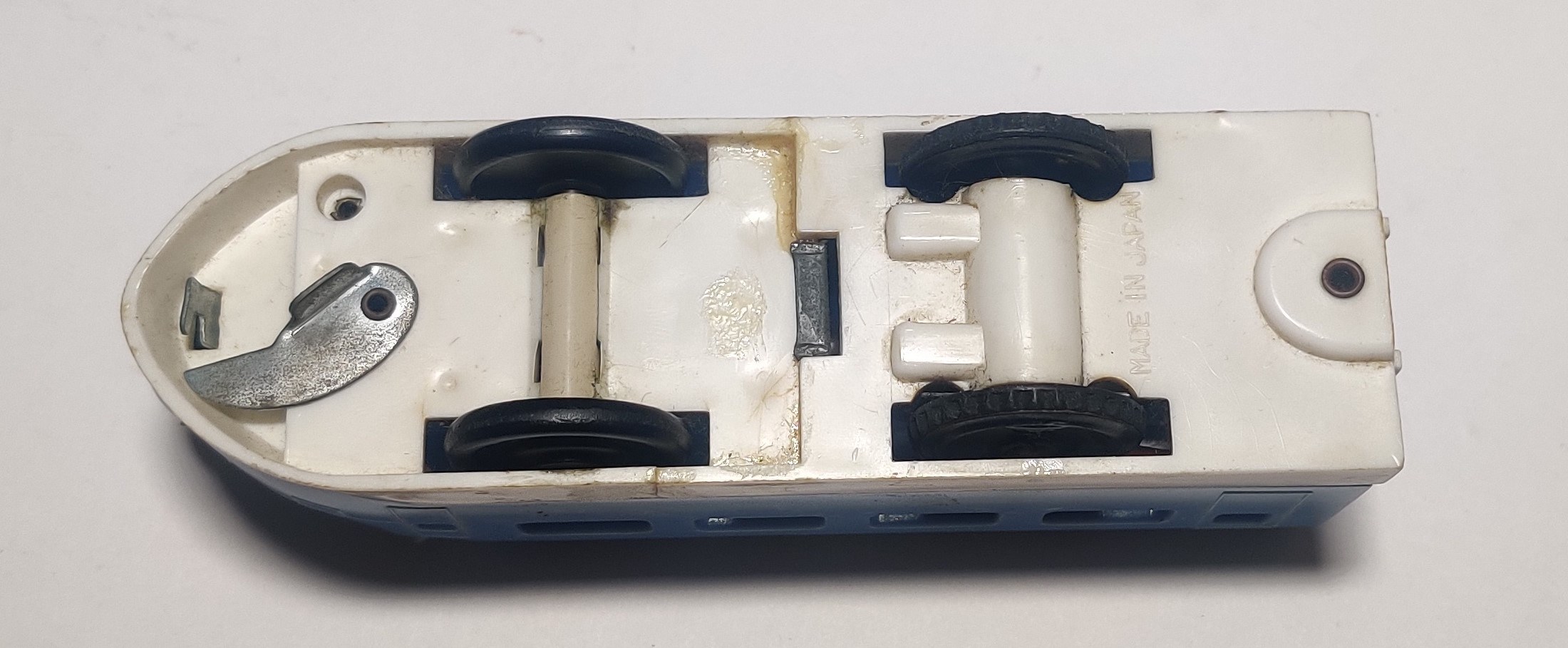
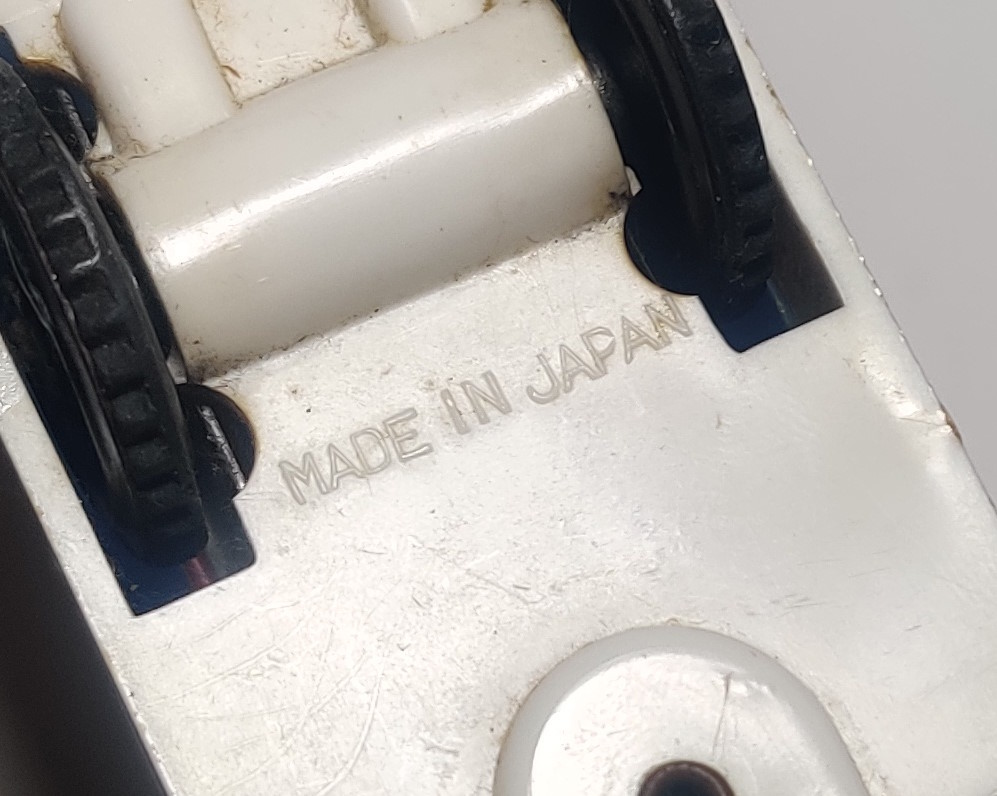
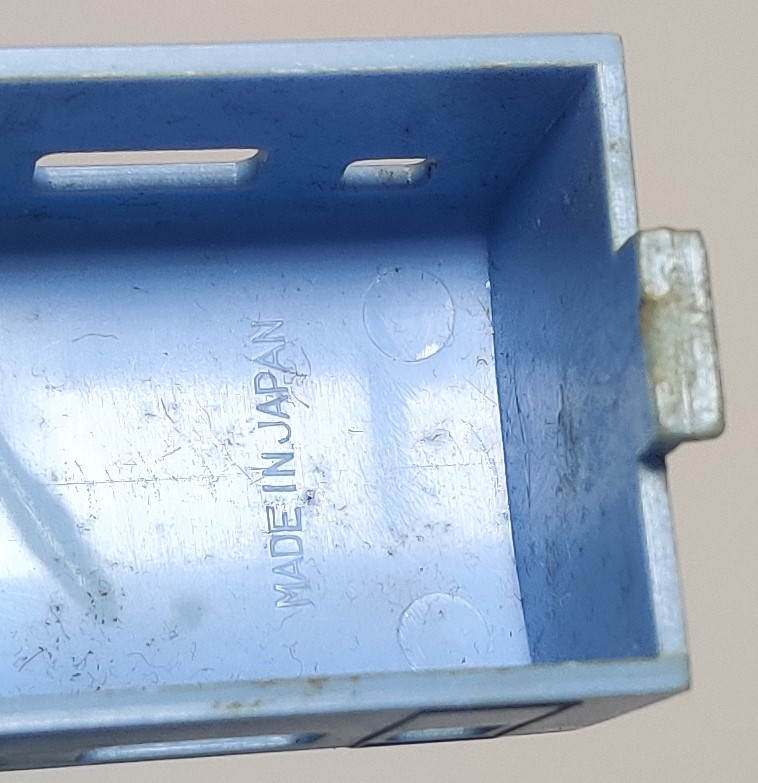
This release has the same style of gearbox and power switch as the original 1964 Hikari and was seemingly exported as early as 1964. The drive wheels are a slightly different design, the original Plarail version used yellow wheels sandwiching large chunky black traction tires similar to the earlier Electric Plastic Train. The train has no rear coupler as it was never intended to pull anything. It is kind of funny that this is close to the inverse of the real 0 series, and that it was only ever exported instead of being sold in Japan.
New Electric Super Express Hikari-go (1966)
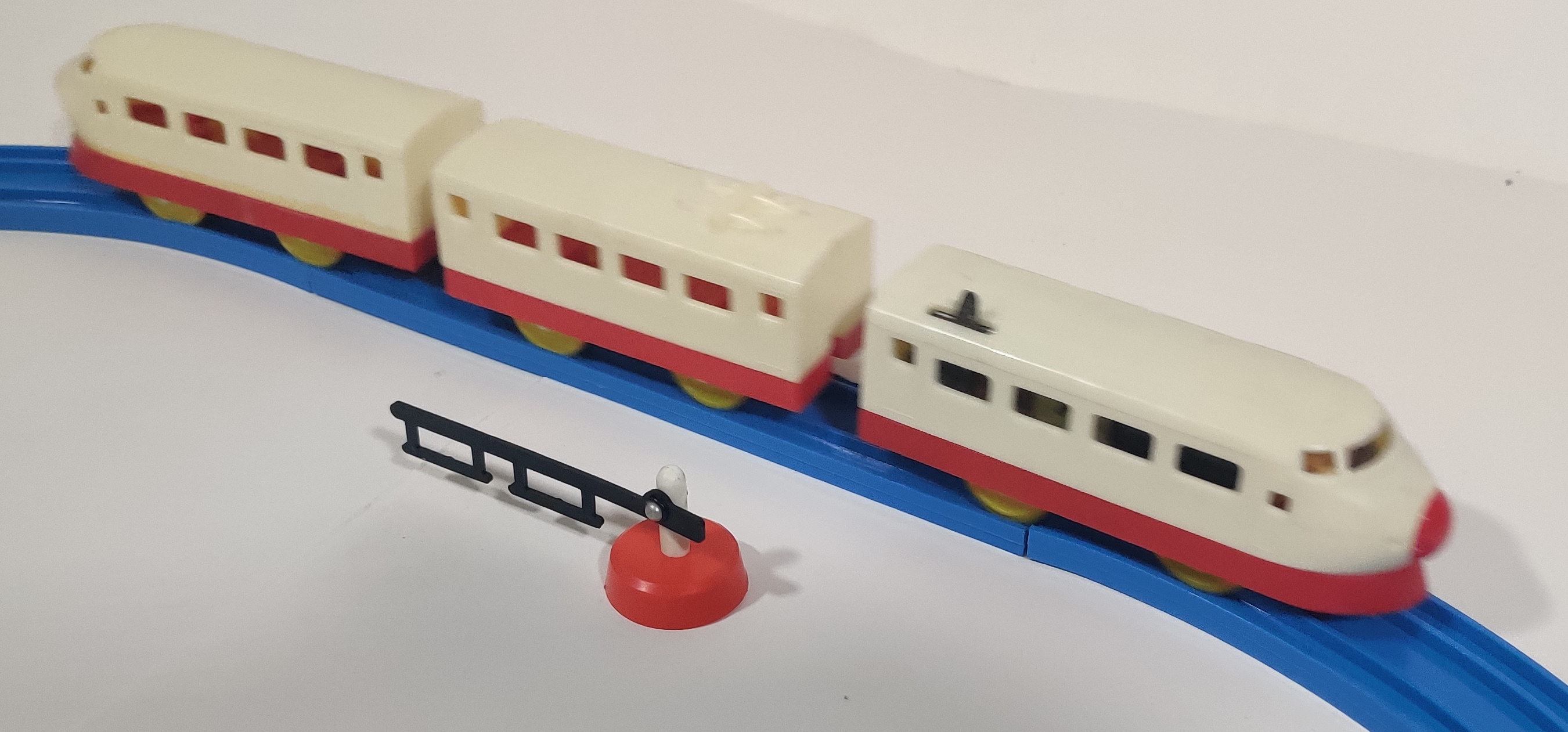
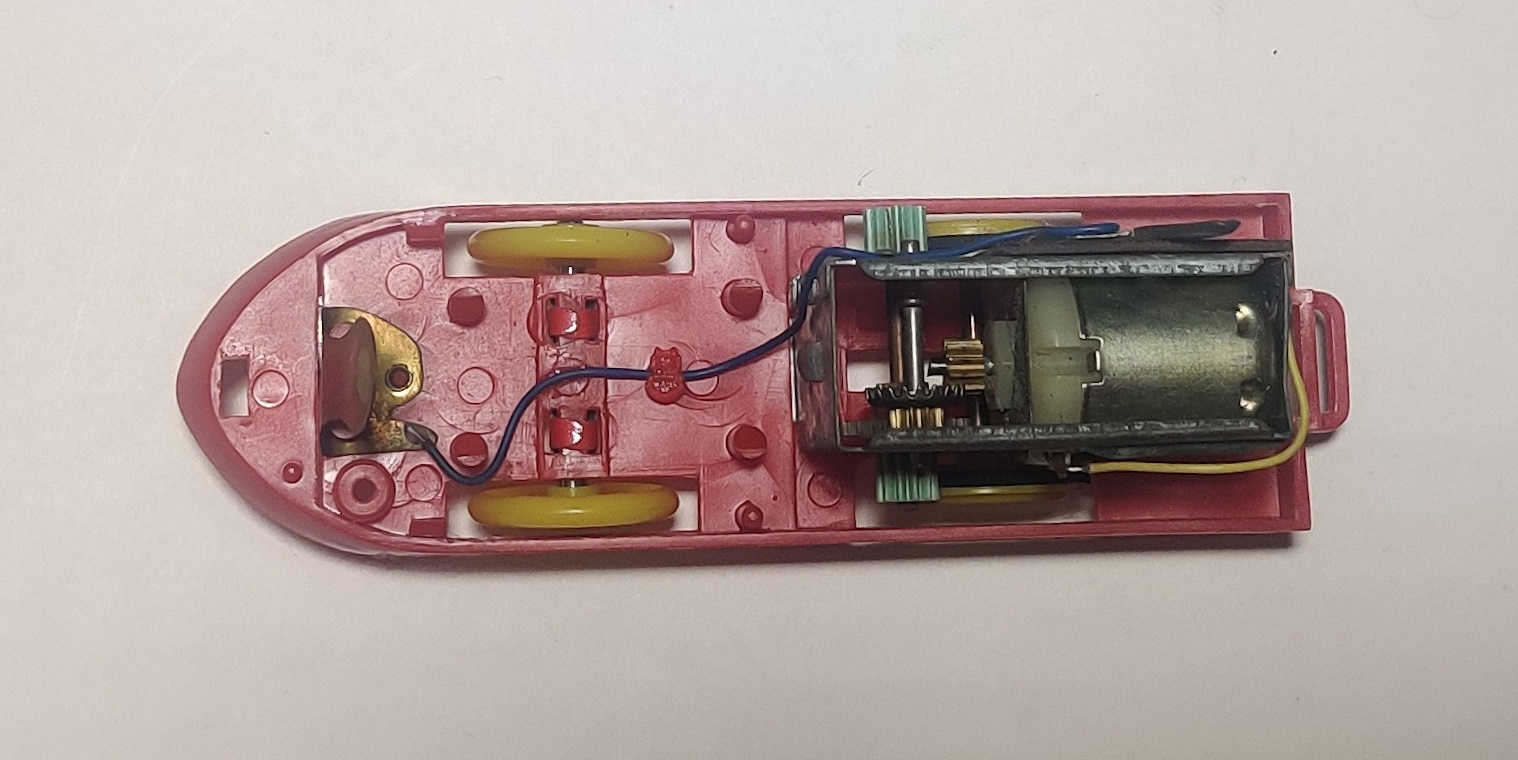
Around 1966 the original gearbox was updated to be friction-drive with the power switch sticking up out of the roof. Boxes had a "New" sticker attached to the box to differentiate from the previous release (新電動超特急ひかり号セット, New Electric Super Express Hikari-go Set). This gearbox uses a contrate gear to transmit the output of the motor 90 degrees with a smaller reduction and has a smaller attached spur gear that drives a larger gear on the axle that the rim drive gears are on. This early gearbox style uses plastic gears on the output shafts to run against the thinner wheels with black traction tires. My example of the New Electric Super Express Hikari comes from the Electric Limited Express Hikarigo Set No.1 from 1968. Japanese Plarail resources consider this to still be a "first generation" Hikari as it still uses the same toolings as the original 0 series, just with a different gearbox.
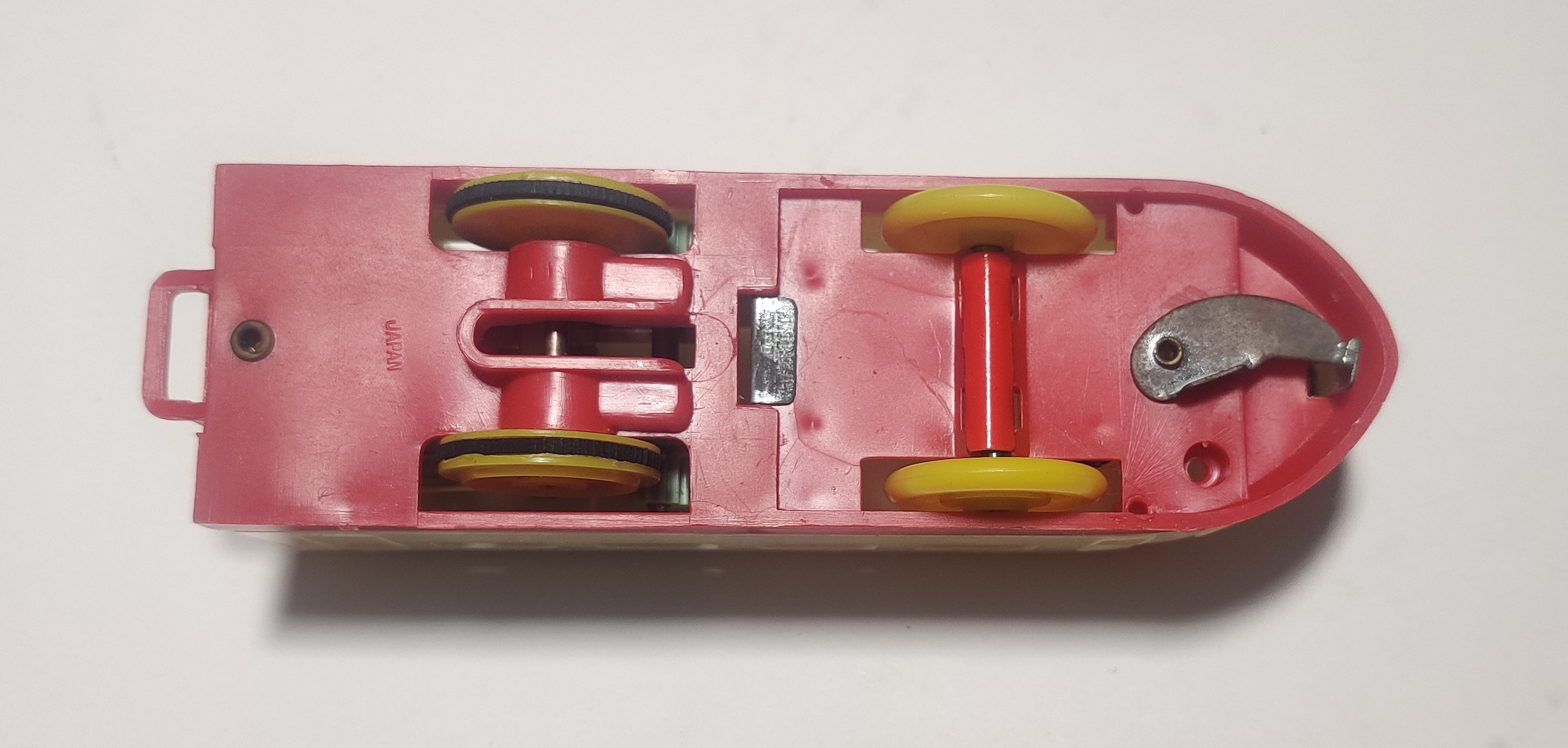
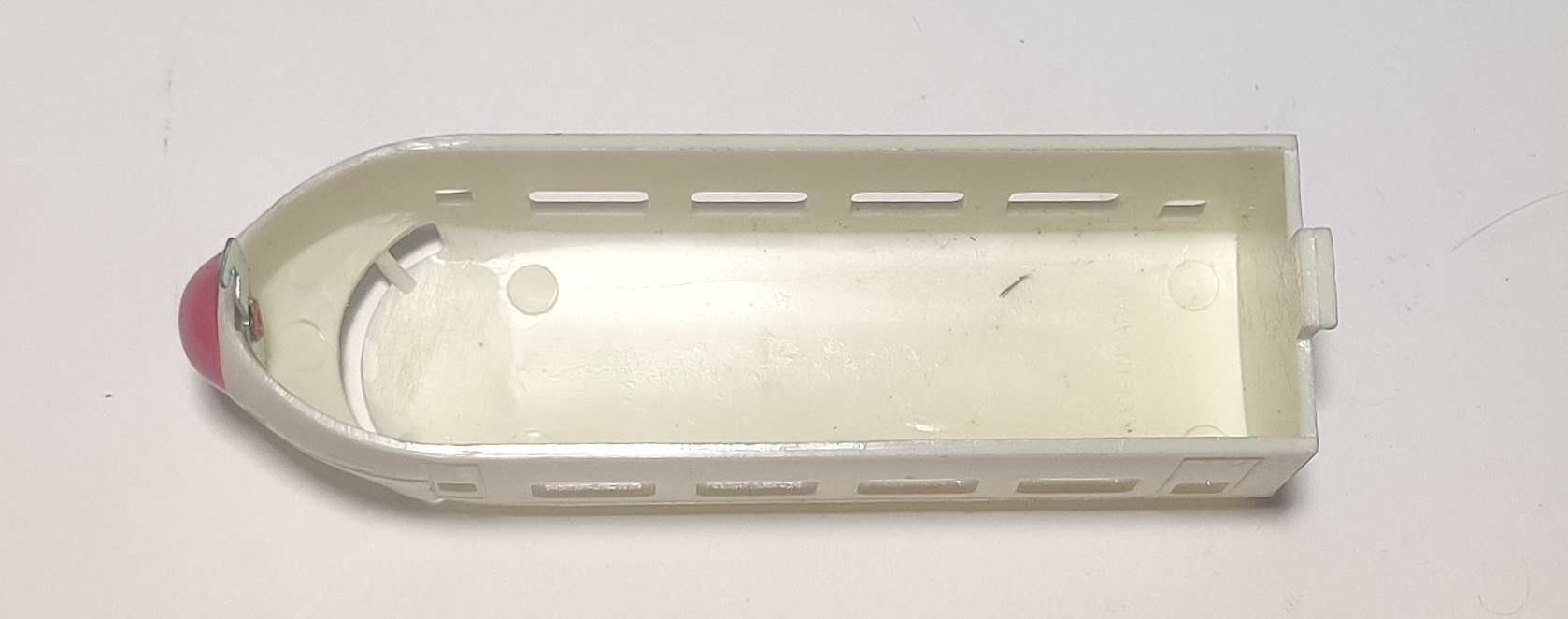
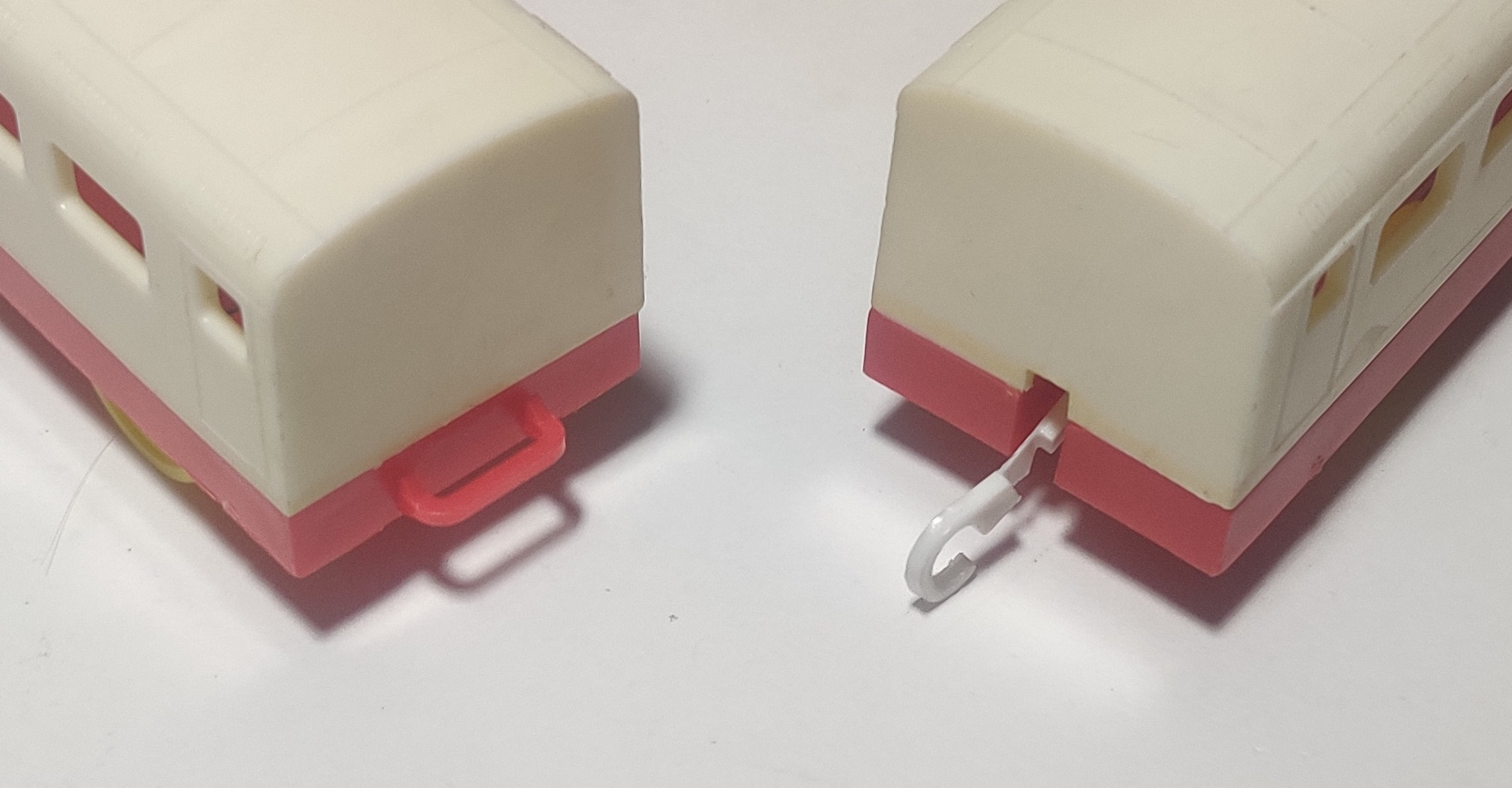
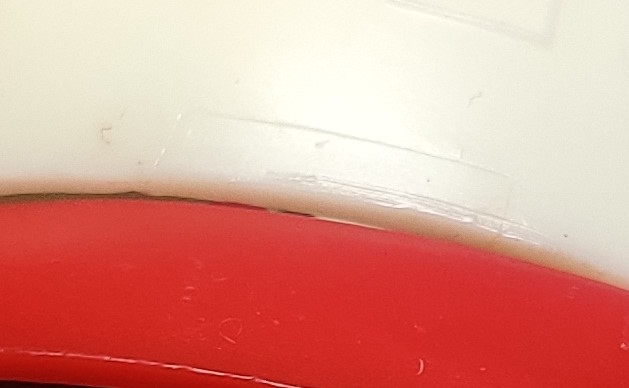
A metal tab at the front of the power car holds a metal claw in the hood down into the chassis like on the previous design. Earlier Electric Super Express Hikaris had metal hook couplings but this "new" example has integrated bars on the rear of rolling stock to connect with the early design of plastic hook coupling. These couplings have a much thinner flexible section to allow the coupling to flex. Similar couplings were also used on Freerail, a 1970s train system from Tomy with flexible, cutable rails that fit into plastic ties. The remnants of the original front power switch can be seen in the molding.
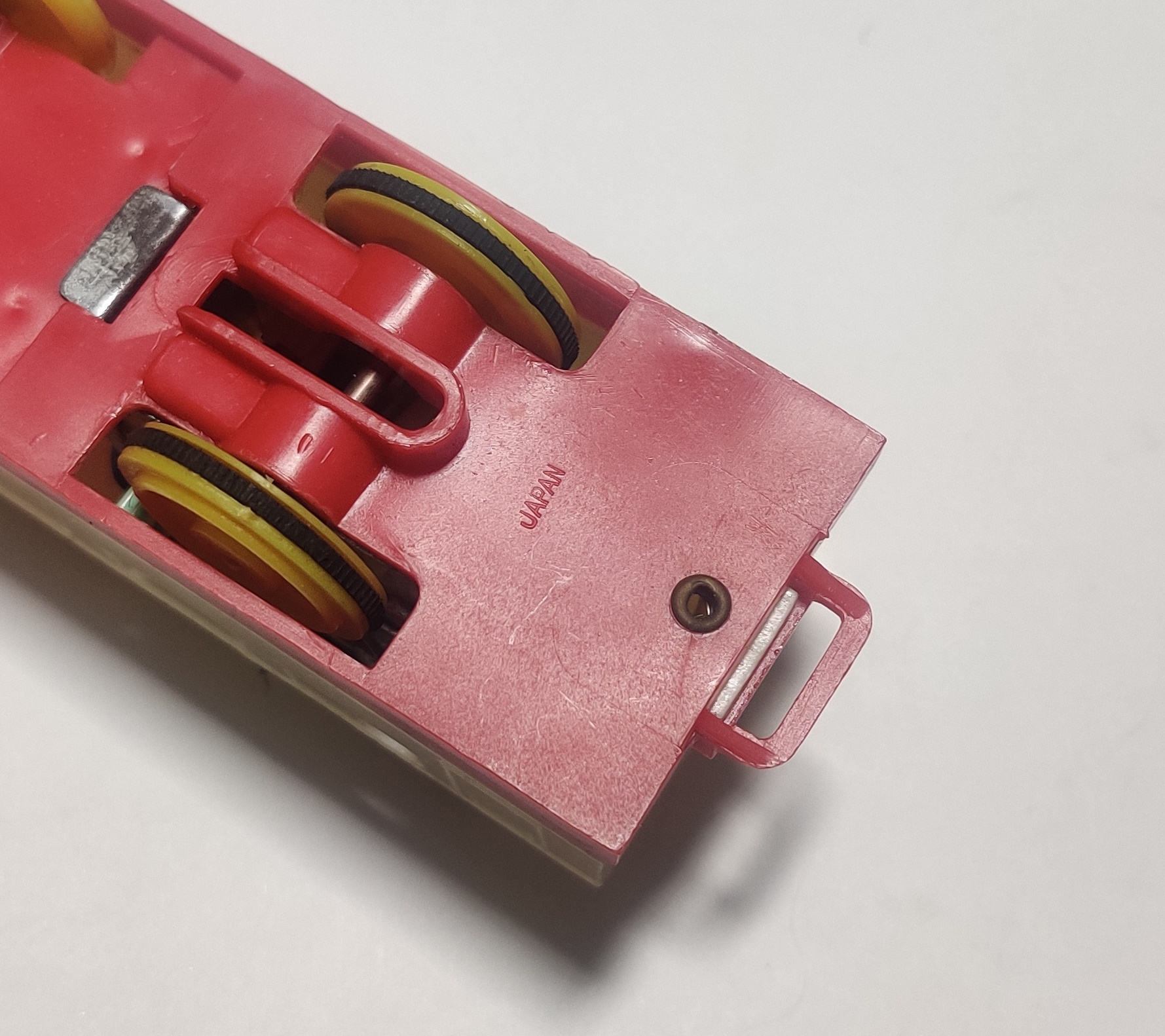
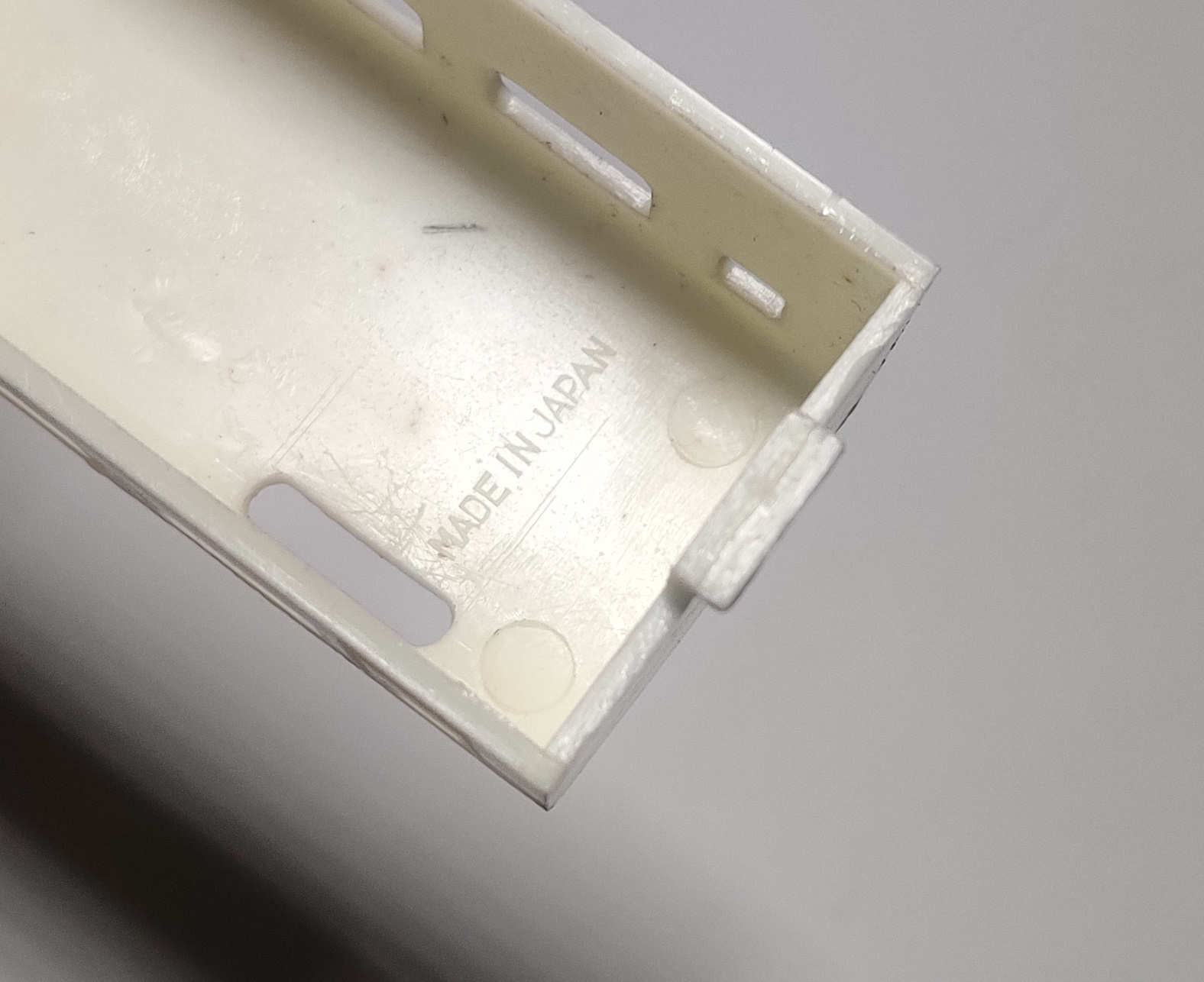
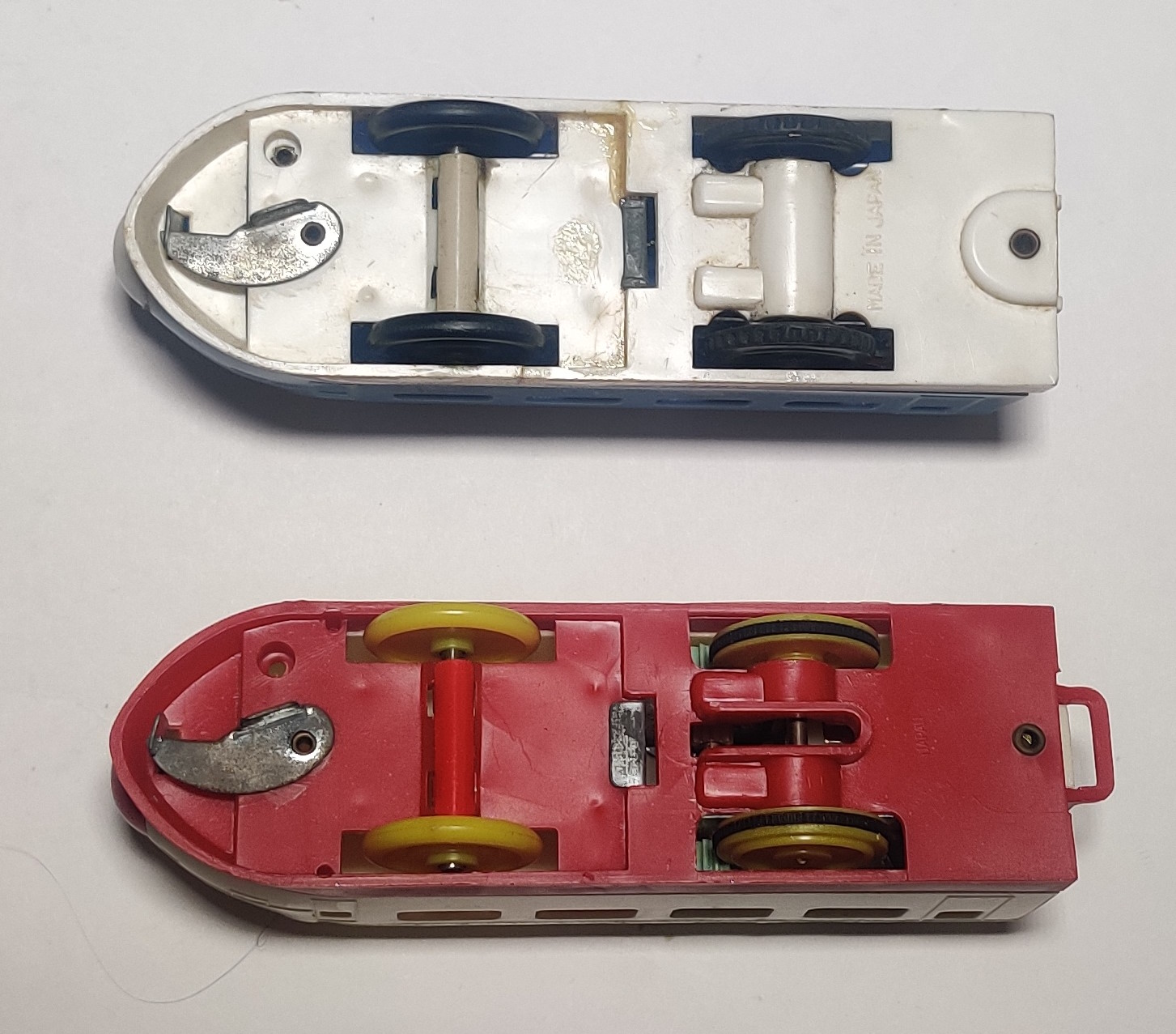
The chassis and shell of the power car are the only components to be marked with a place of manufacture. The "activation tab" cutout was also added to the chassis with this revision, with activation tab system accessories like the amusement park series first appearing in the later 1960s.
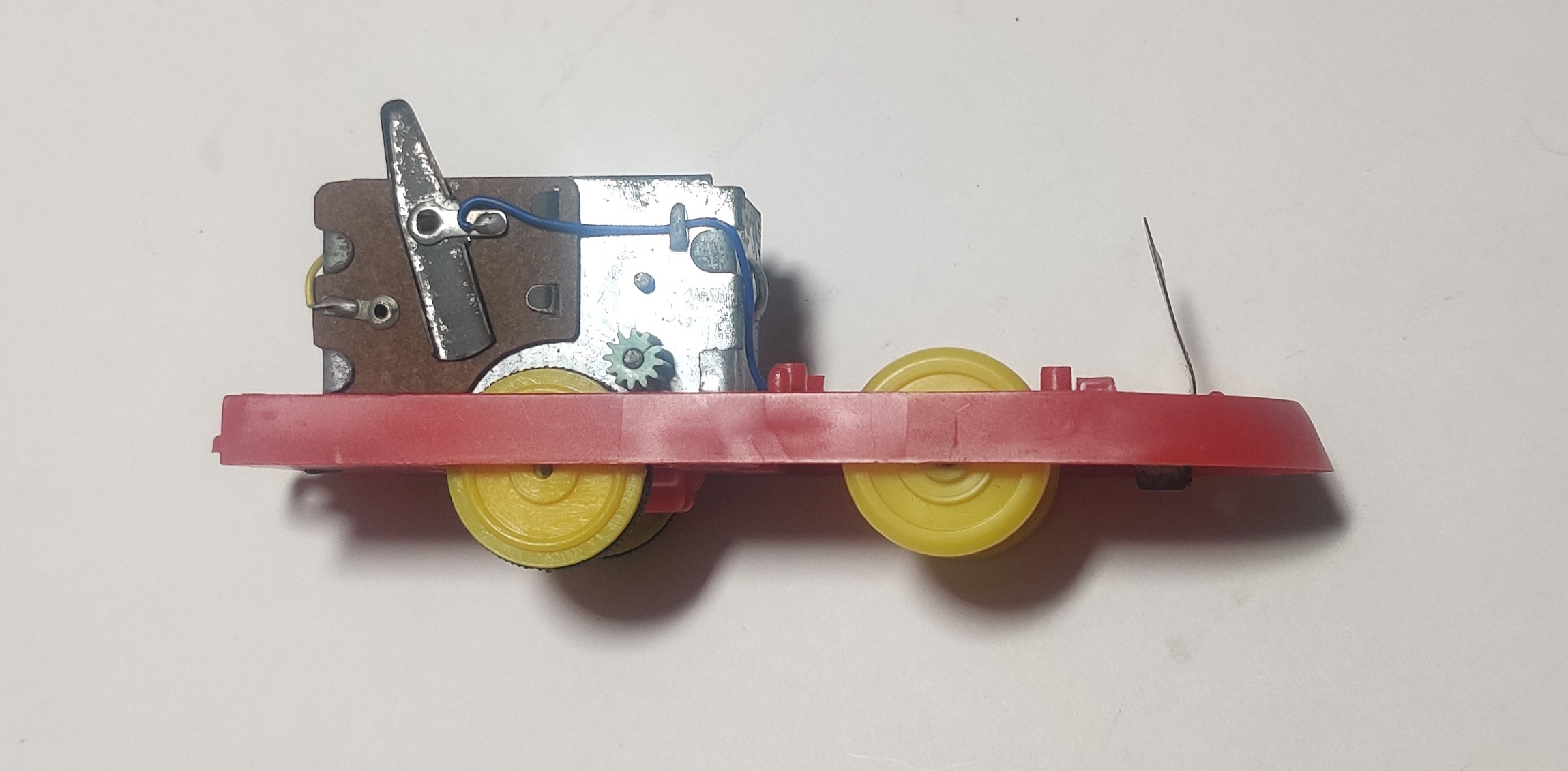
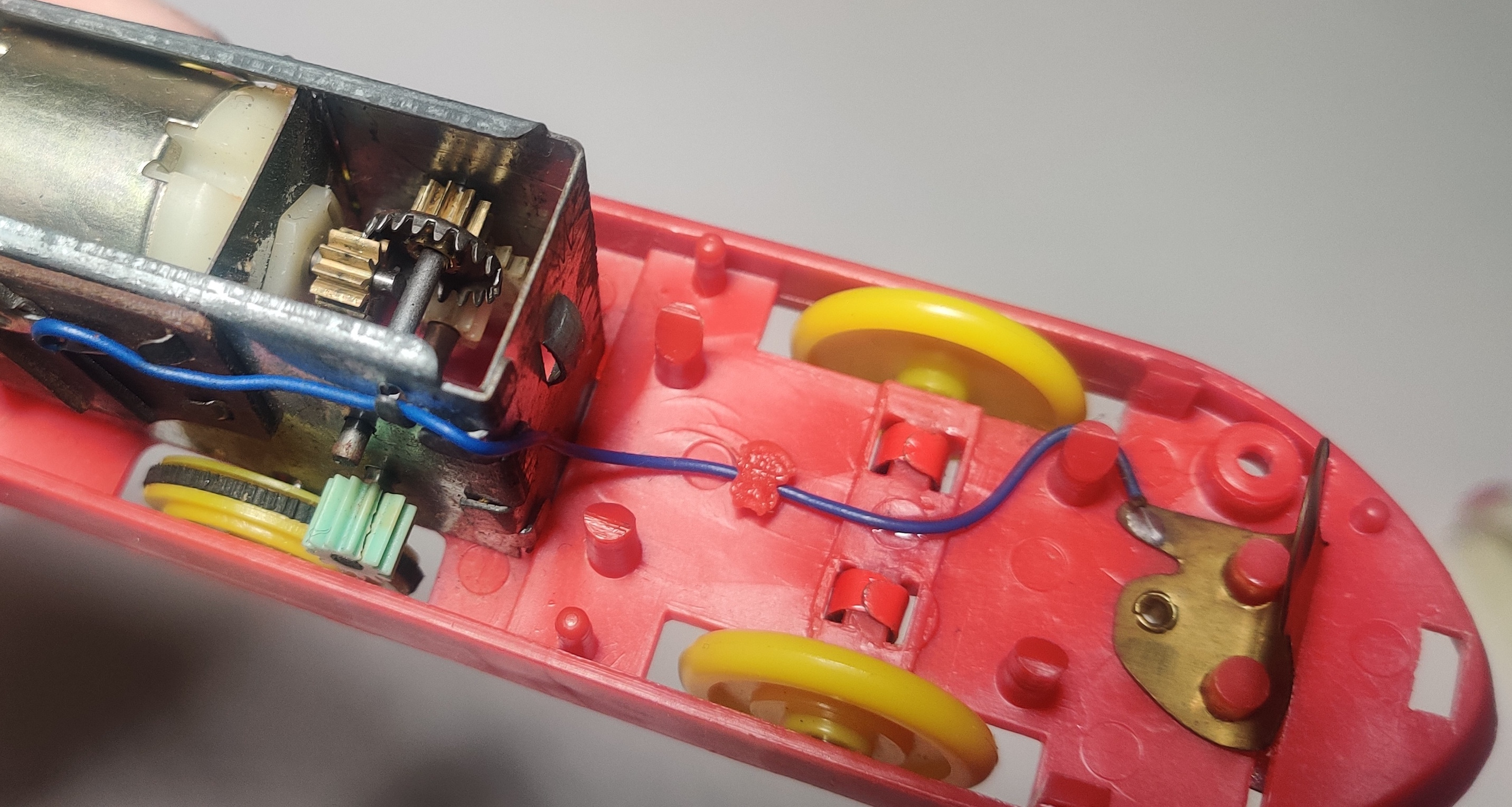
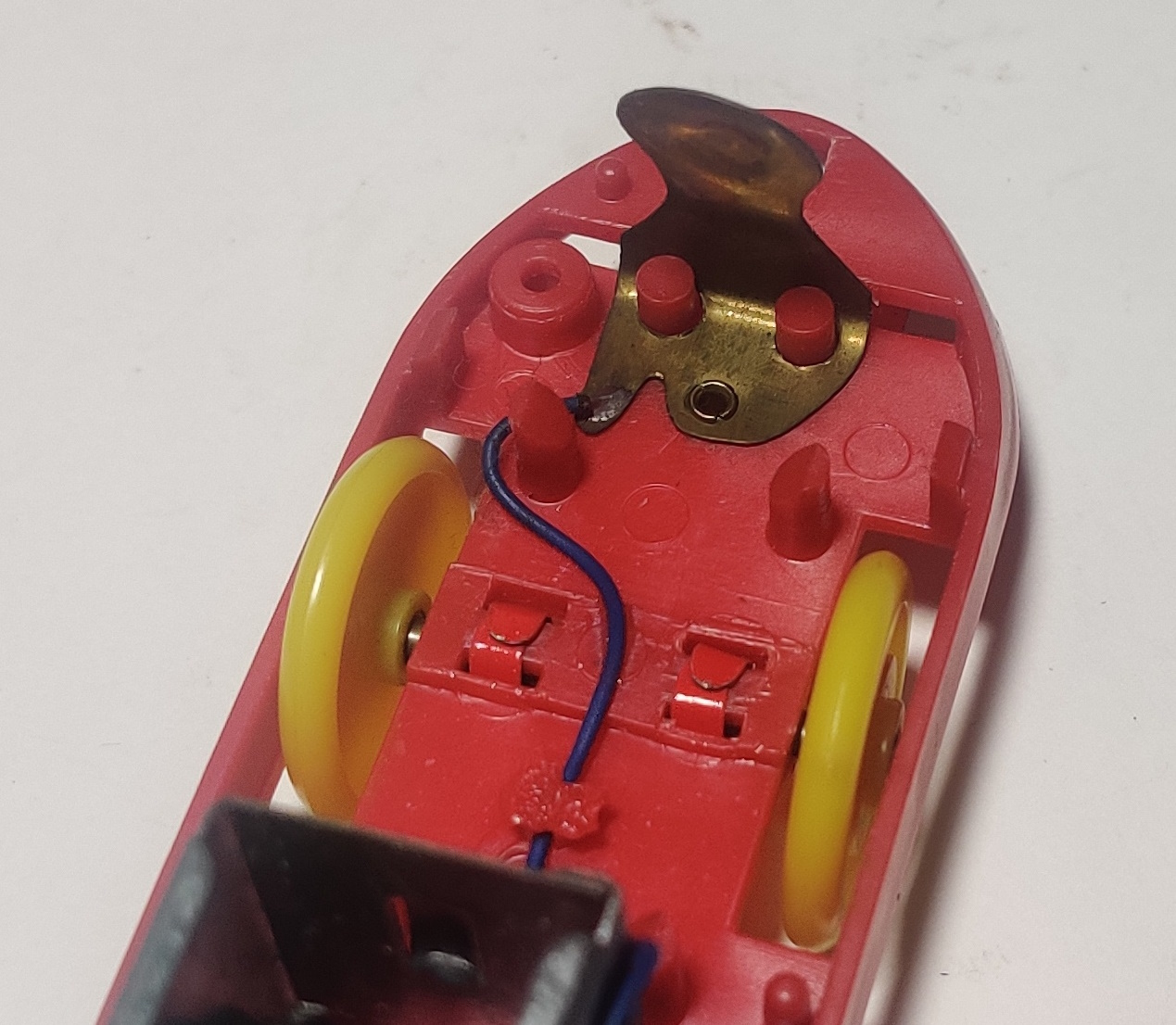
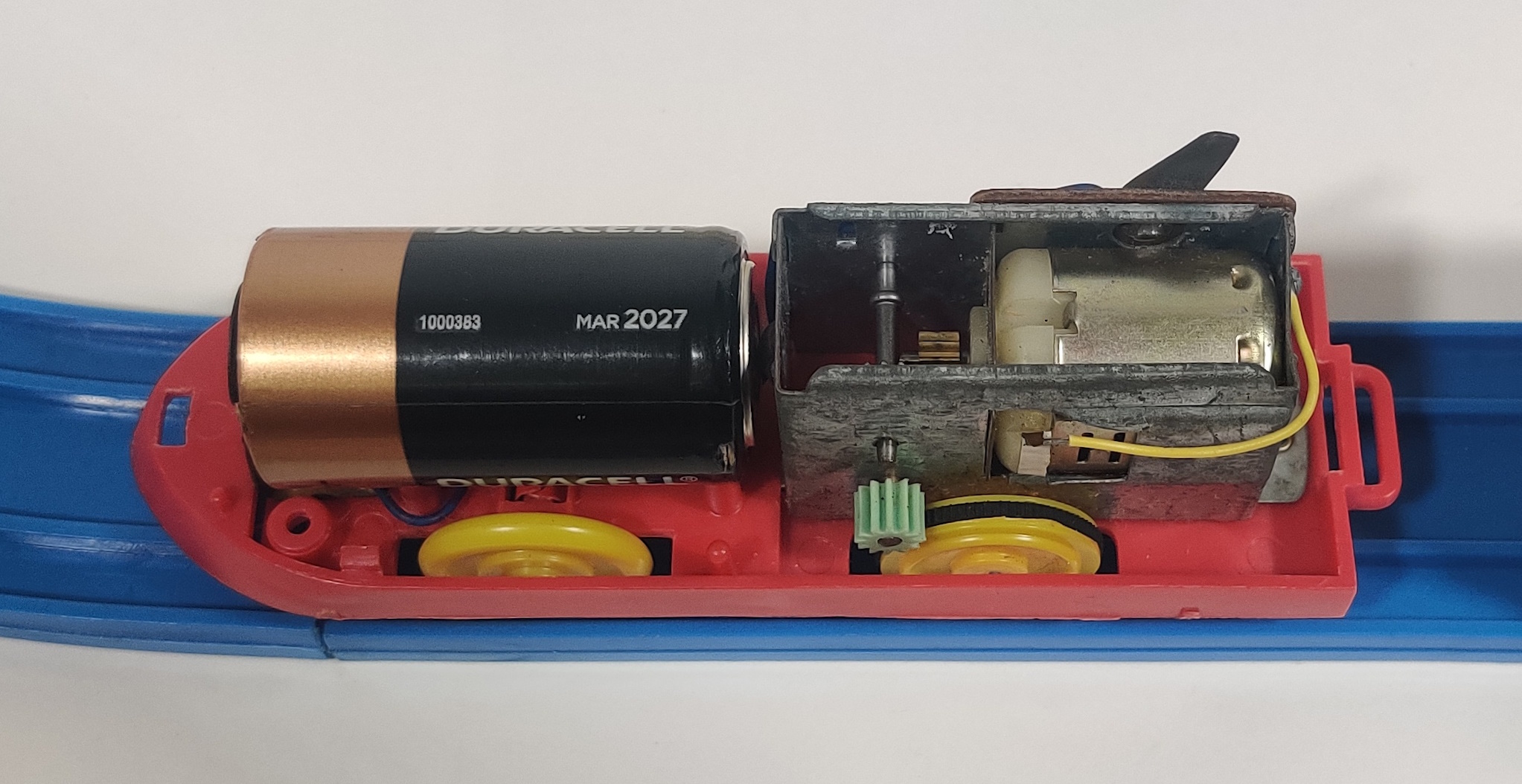
This second-generation drive train has the power switch sticking up through a hole in the roof instead of the earlier (and later) front switch systems and like the later new-power gearbox. It uses small gears on the output shaft to friction-drive the rear wheels, which use thinner black traction tires. Both of the original gears on my example are cracked, but as they do not mesh with another gear this does not matter as much as in other gearboxes as long as they do not spin freely on the shaft. The power switch mechanism is fairly simple and does not disengage the gears in the gearbox in any way, only turning off the motor. The front battery contact is large and brass like the original gearbox variant. The cylindrical molding feature near the front battery contact is where the original design of front power switch was installed. Unpowered wheels are held into the chassis using metal holders that wrap around the axles and have metal tabs that hold the axle to the chassis. The battery is installed with the positive side of the battery facing the front of the power car instead of the gearbox like pretty much all later locomotives.
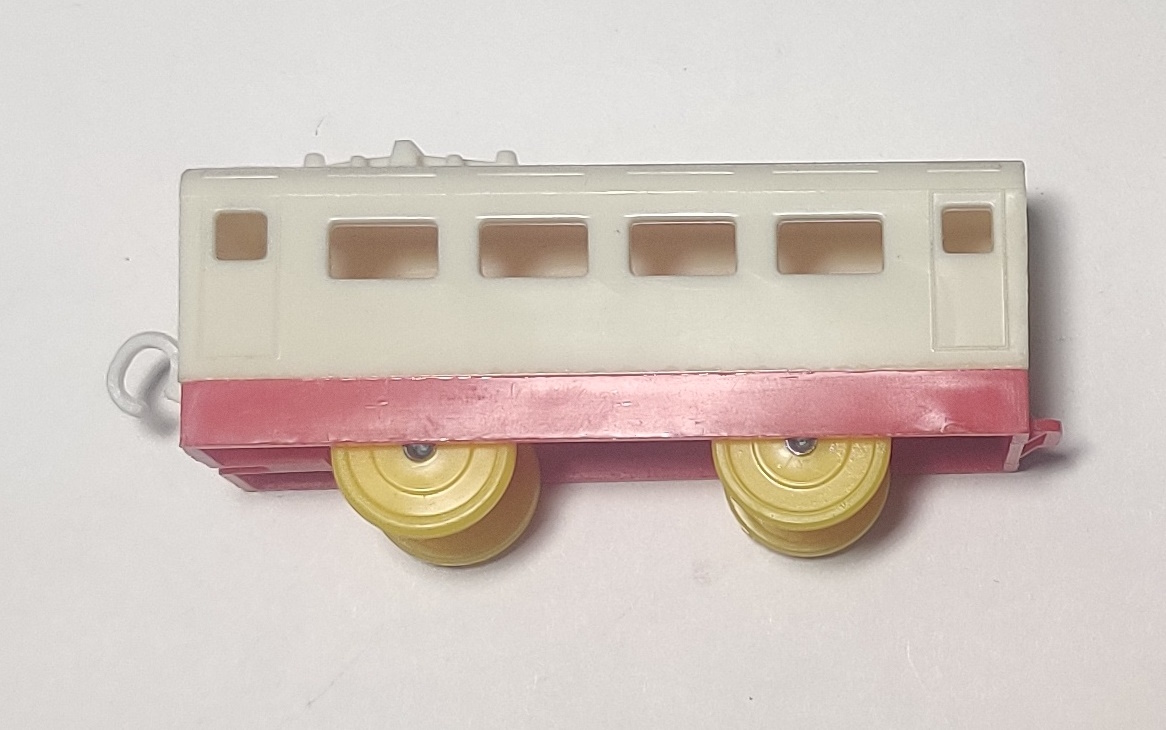
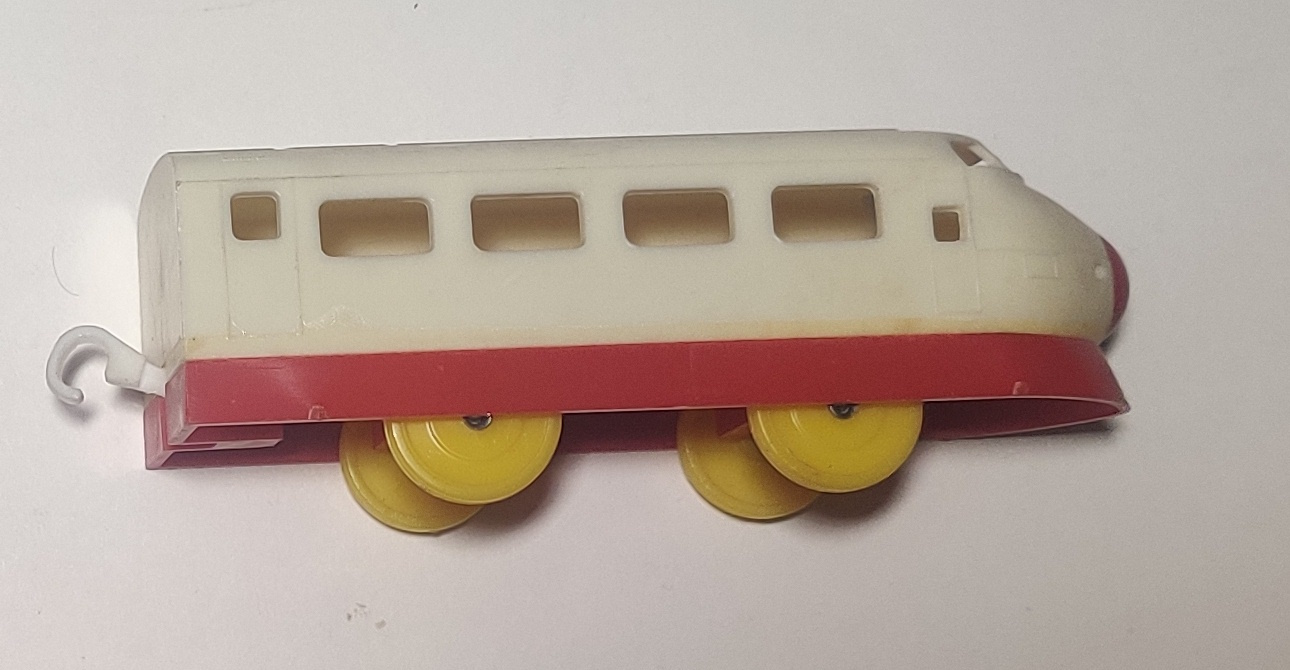
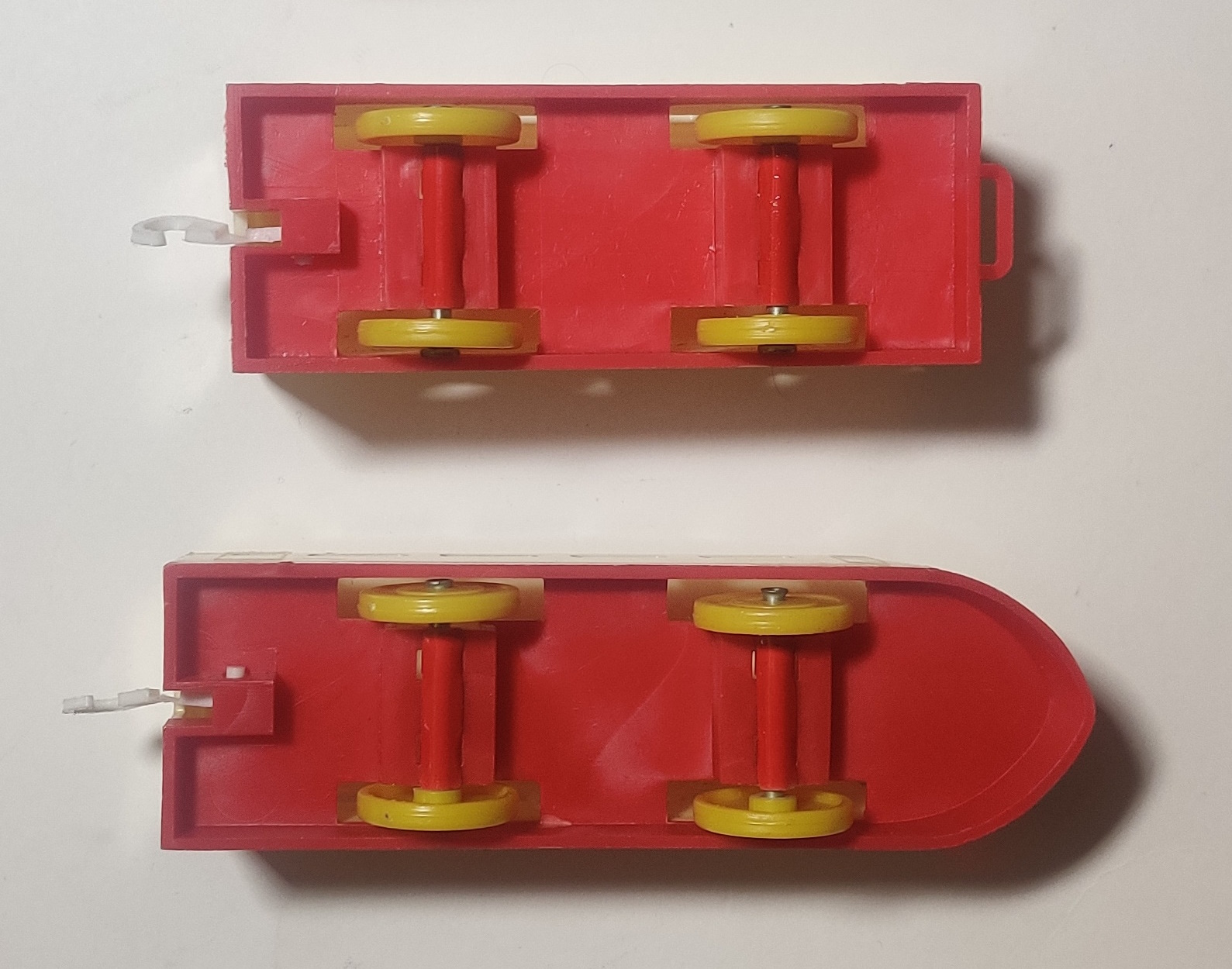
The intermediate car's pantograph is molded into the body shell, unlike the later 0 series and other newer Plarails that use the same style of pantograph. The intermediate and tail cars' shells are glued to the chassis, making replacing couplings or wheels a pain (if not impossible without destroying the plastic). Wheels are held in with metal holders similar to the power car. The fragility of the coupling system as well as the inability to replace them both helped influence the development of the improved coupling systems and car chassis used since.
Electric Super Express Hikari-go (1970)/Super Express Hikari-go (1971)
Around 1970 (if not late 1969) the molding of the upper body of the power and tail car of the 0 series was updated to look more like the production 0 series instead of the prototype 1000 series with rectangular door windows, although the original intermediate car tooling remained. This is considered to be the "second generation" Hikari, as it was the first time the main body shell molds were changed. This version of the 0 series returned to a front-mounted power switch that stuck out from the chassis similar to the first generation drive system (although through a slit in the chassis rather than a cutout in the body shell) instead of the roof like the second generation drive system. The gearboxes were all-metal and more similar and of the type used on many other 1970s trains. The couplings were updated to the thicker early 1970s style and the integrated rear couplers were changed for the early full loop types. In 1971 this version of the 0 series was released in a new style of box. These Hikaris used the more widely-used old power gearboxes. Early examples of this generation of 0 series use the gear drive system while later ones use the black rim-drive drums.
Super Express Hikari (1972)/Super Express Hikari (1974)
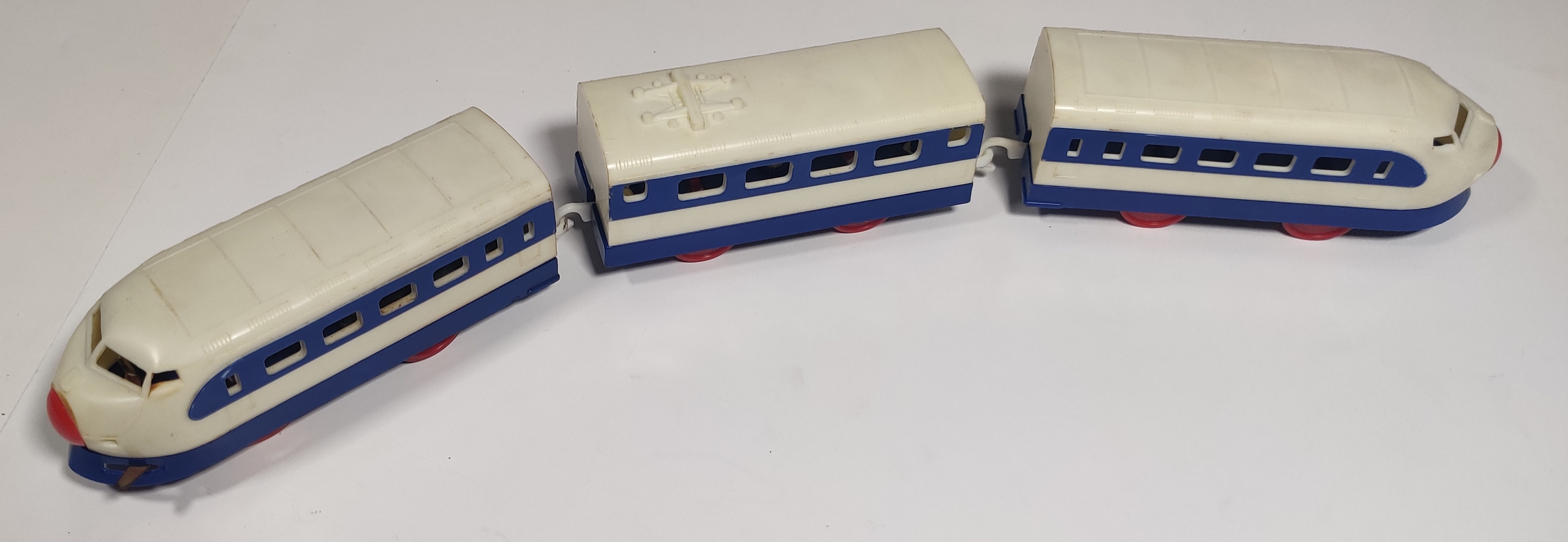
In 1972 the second-generation box Super Express Hikari (超特急ひかり号) was updated to represent the blue and white color scheme of the real 0 series train and had red plastic noses. It used a slight variation of the earlier intermediate car molding, still with square windows in the doors, but with an added ridge around the doors for the blue stripe.
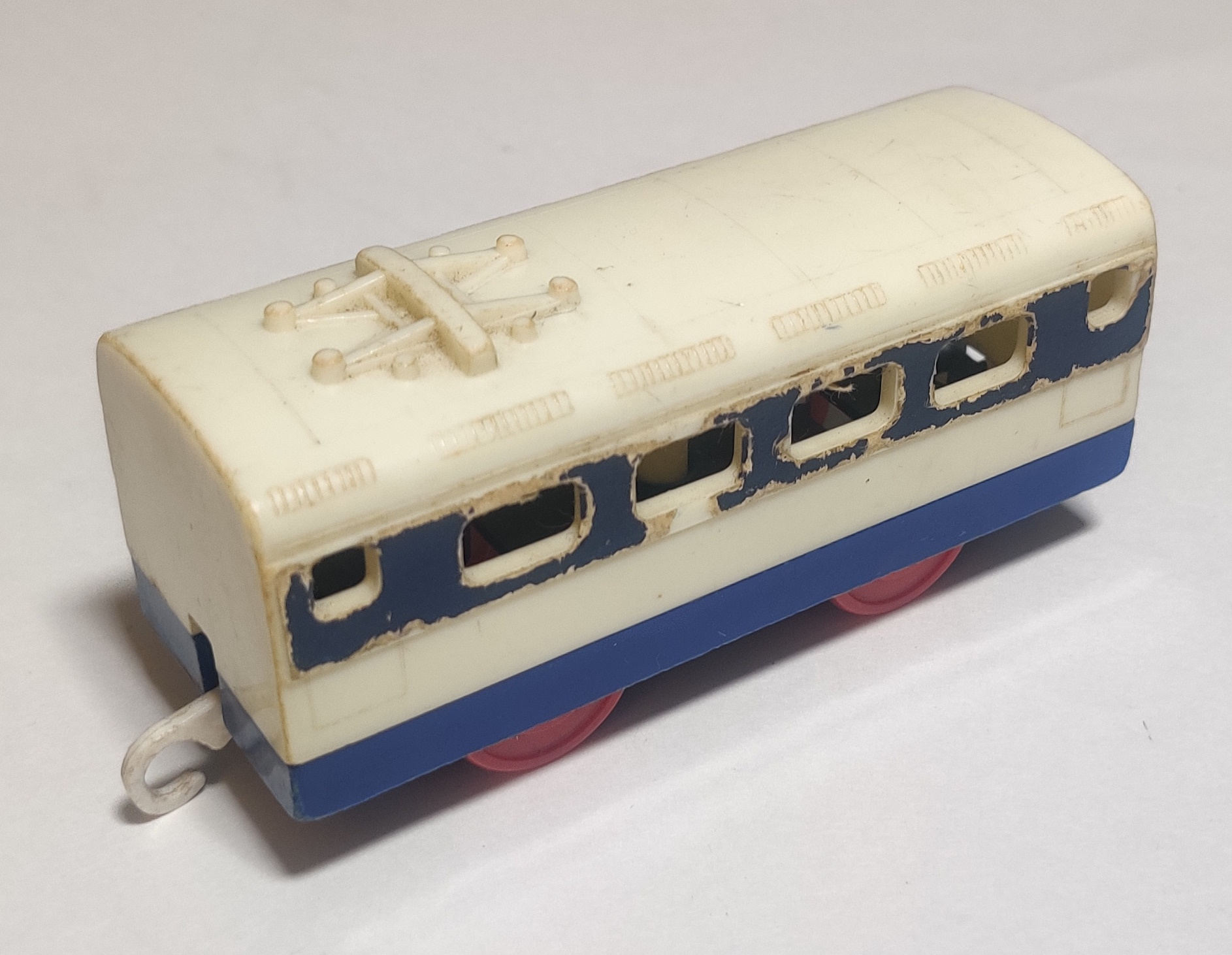

Earlier examples have blue stickers applied around the windows on the raised sections, with some very early examples seemingly not having the stickers at all, just the updated tooling and blue chassis.
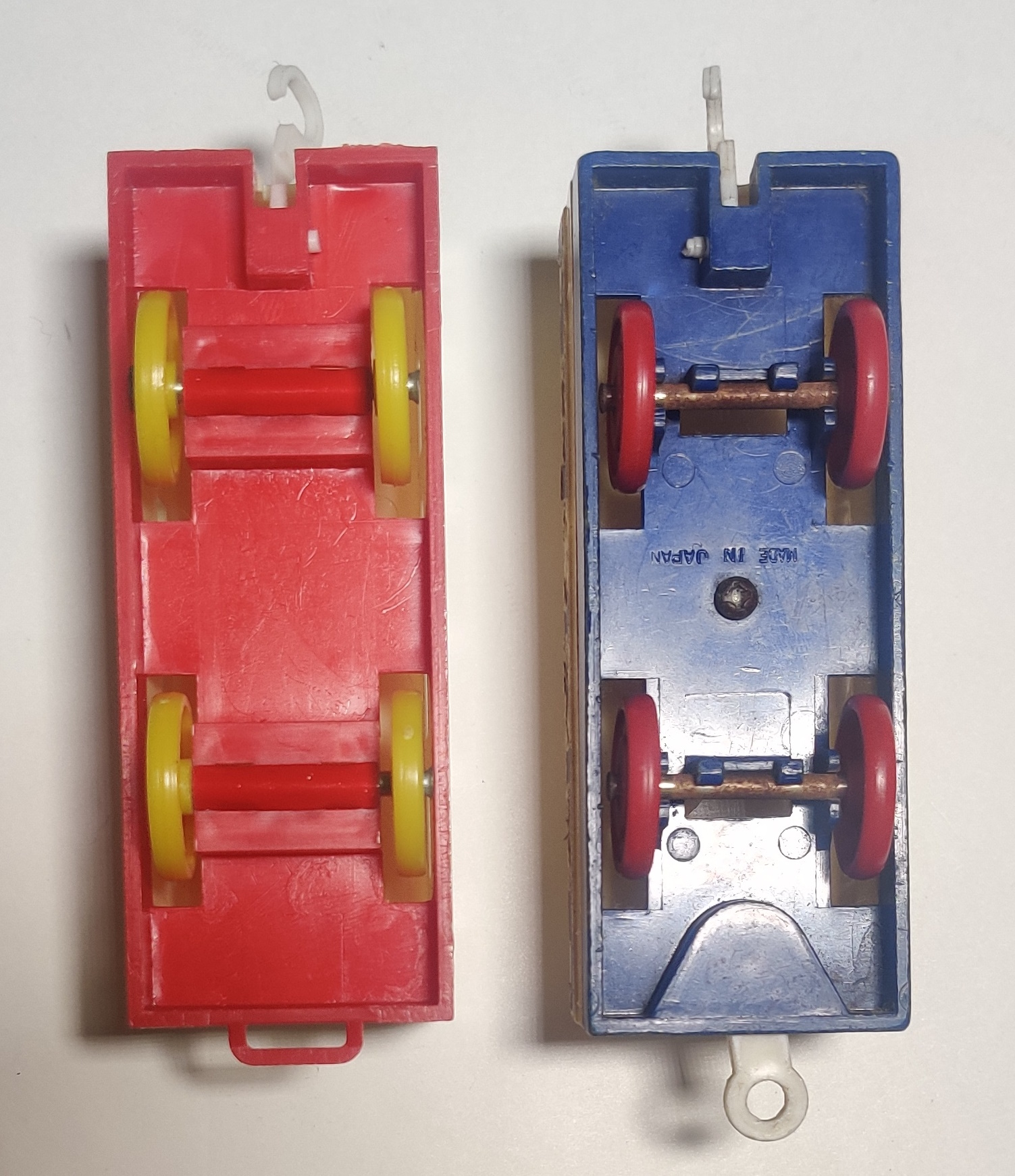
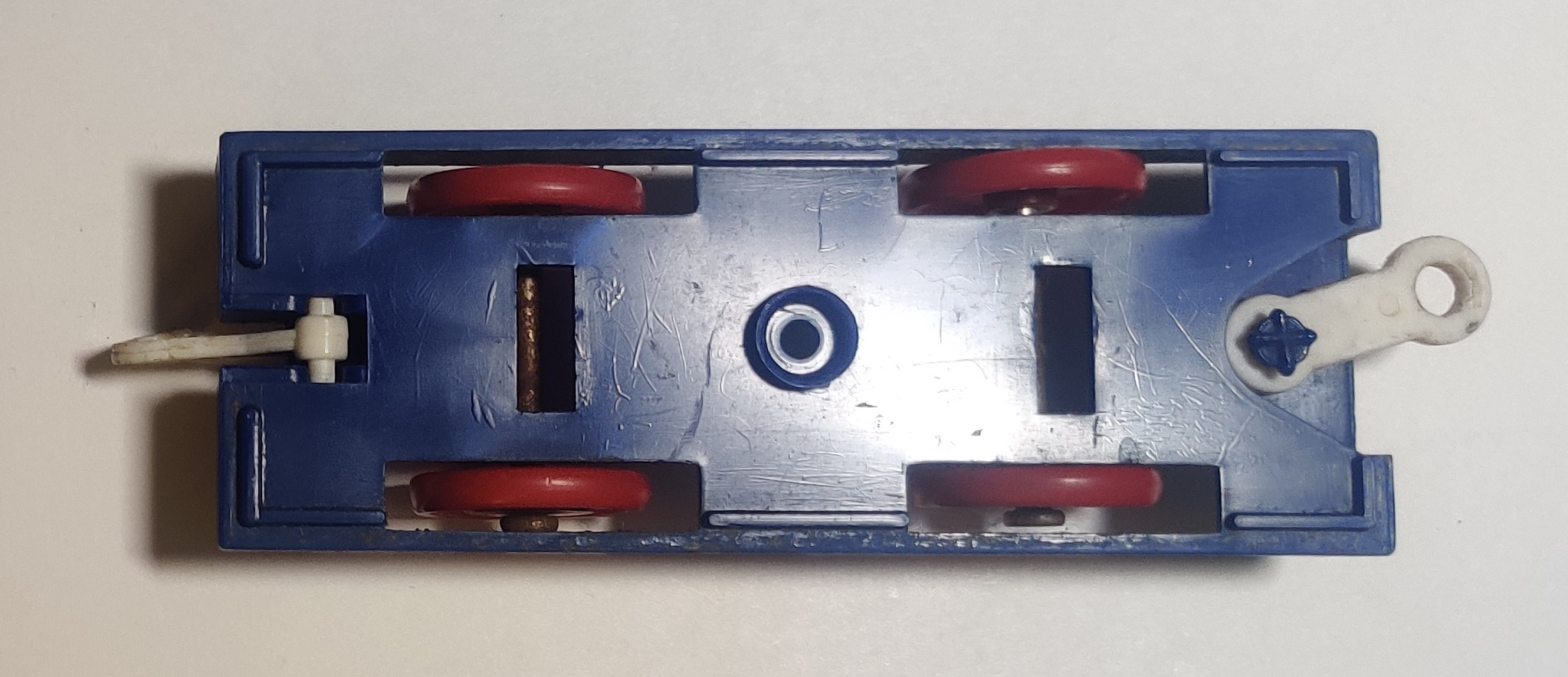
Because these newer chassis are screwed onto the body shells instead of glued, this offers a look at the inside of the early Hikari intermediate car and the early 1970s full-loop and chunky hook coupling system.


From 1974 to 1976 the Super Express Hikari was sold in the third generation box type as ちょうとっきゅうひかりごう. Later mid 1970s Super Express Hikaris have painted window surrounds instead of the earlier sticker type, with the couplings transitioning to the almost-modern 1970s type in the mid 1970s.
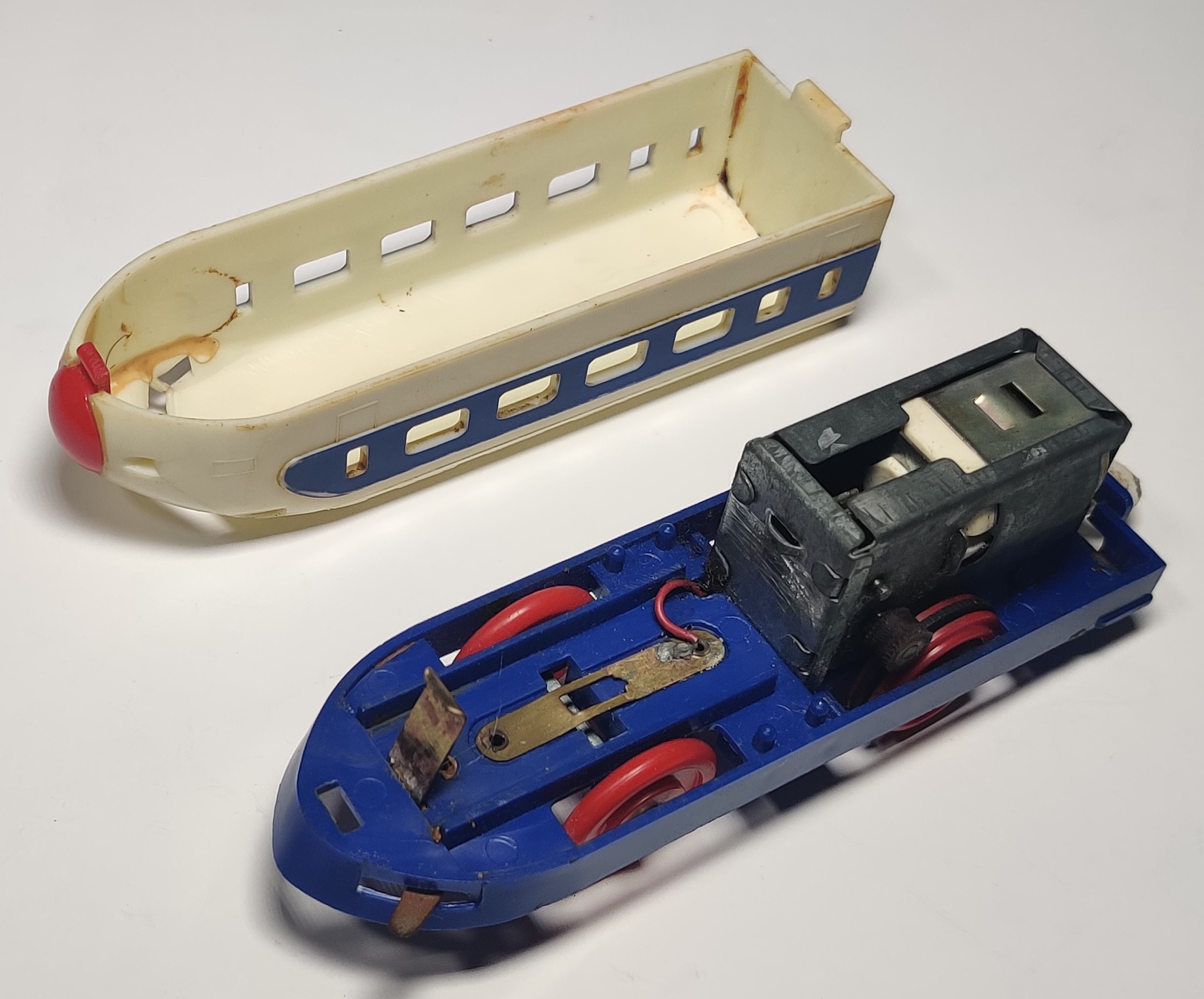
The red nose cone also serves as a clip to hold the body shell in place. The power car uses the third-generation drive system and the second style of old-power gearbox, with this example having the rubber drive tires and old thinner wheels with thin black traction tires.
New Hikari (1976)/Hikari (1977)
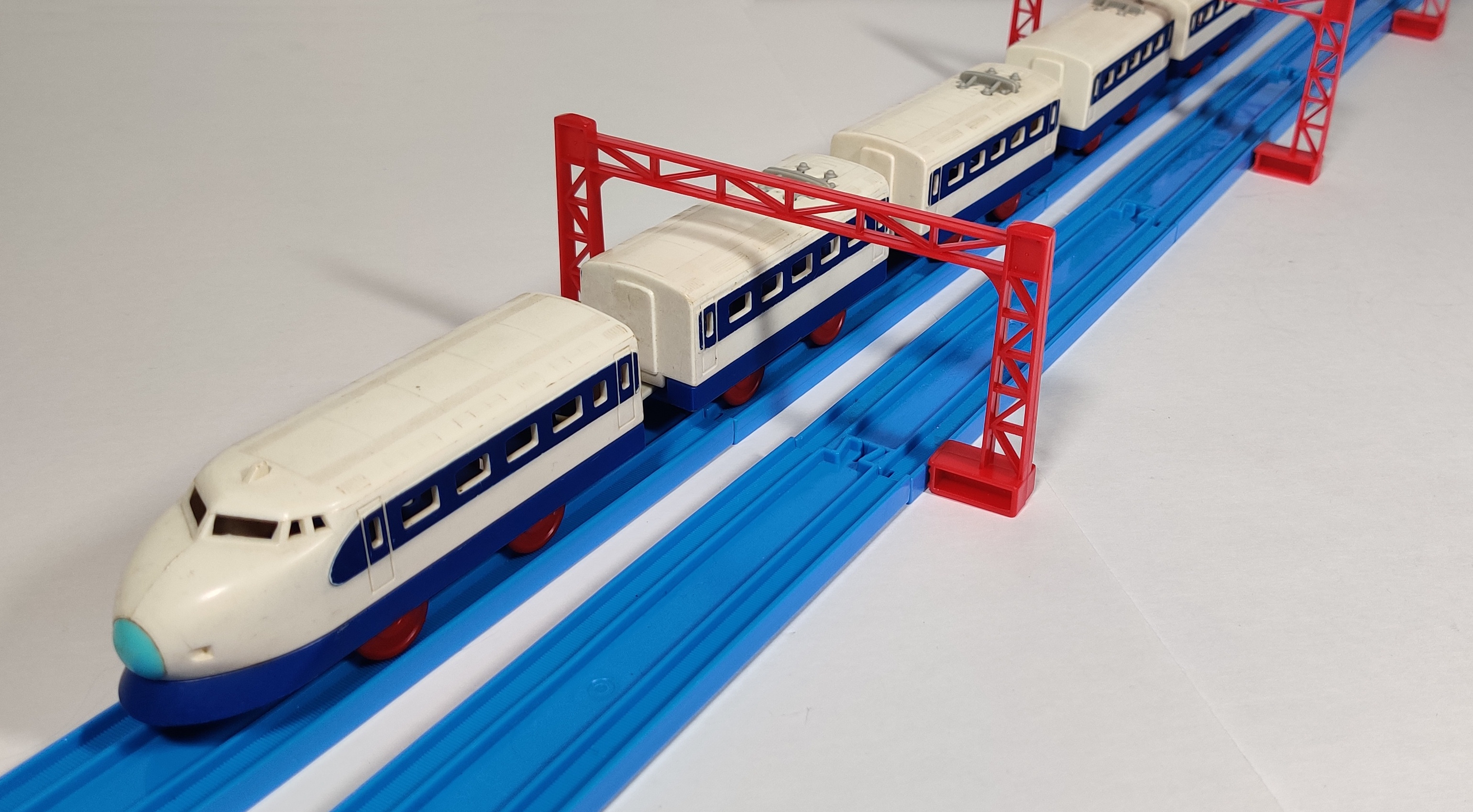
In 1976 the new-tooling New Hikari (ニューひかり号), rereleased the next year as just the Hikari (ひかり号), was released with a new chassis that fit the original plastic style of old-power friction-drive gearbox.
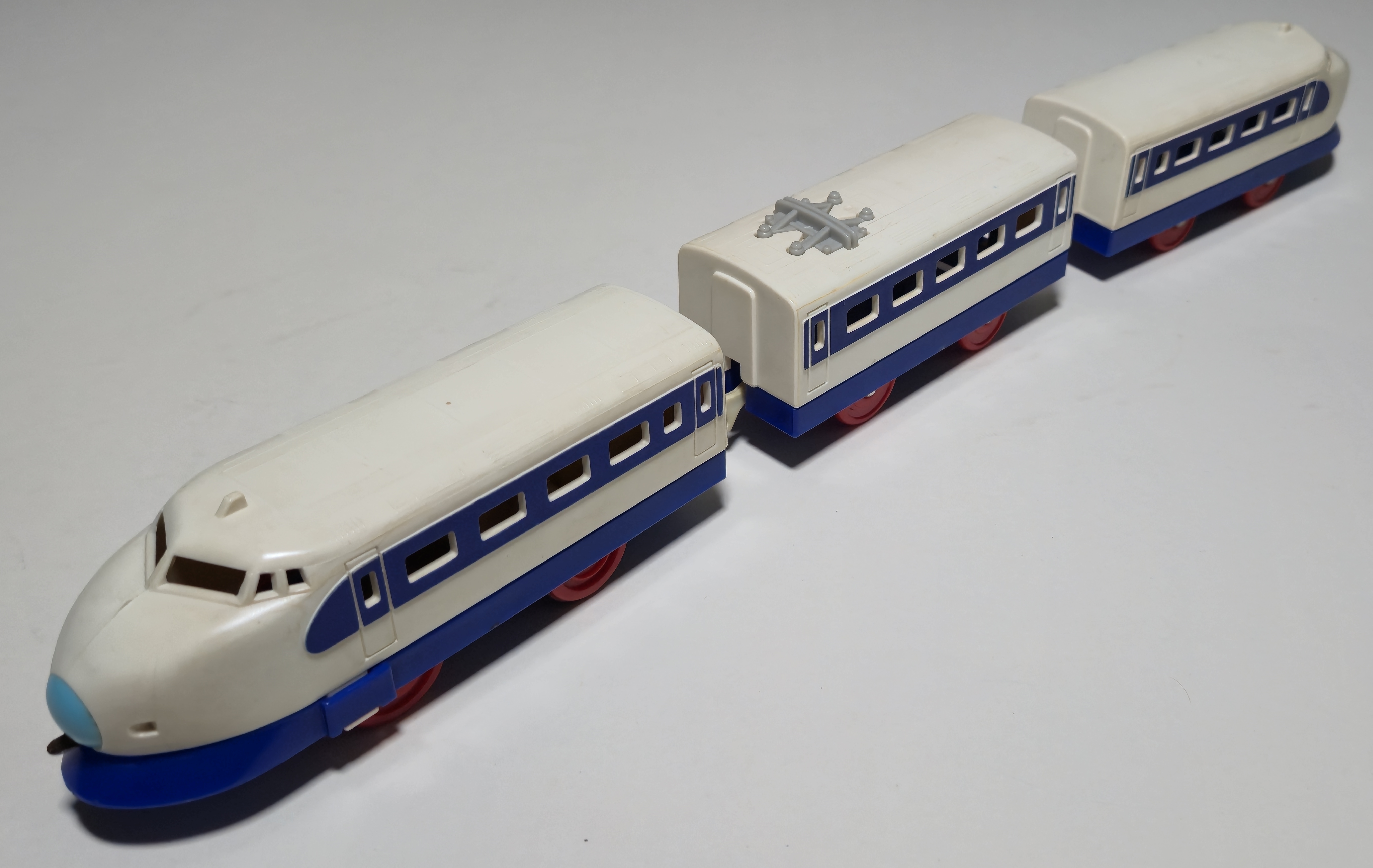
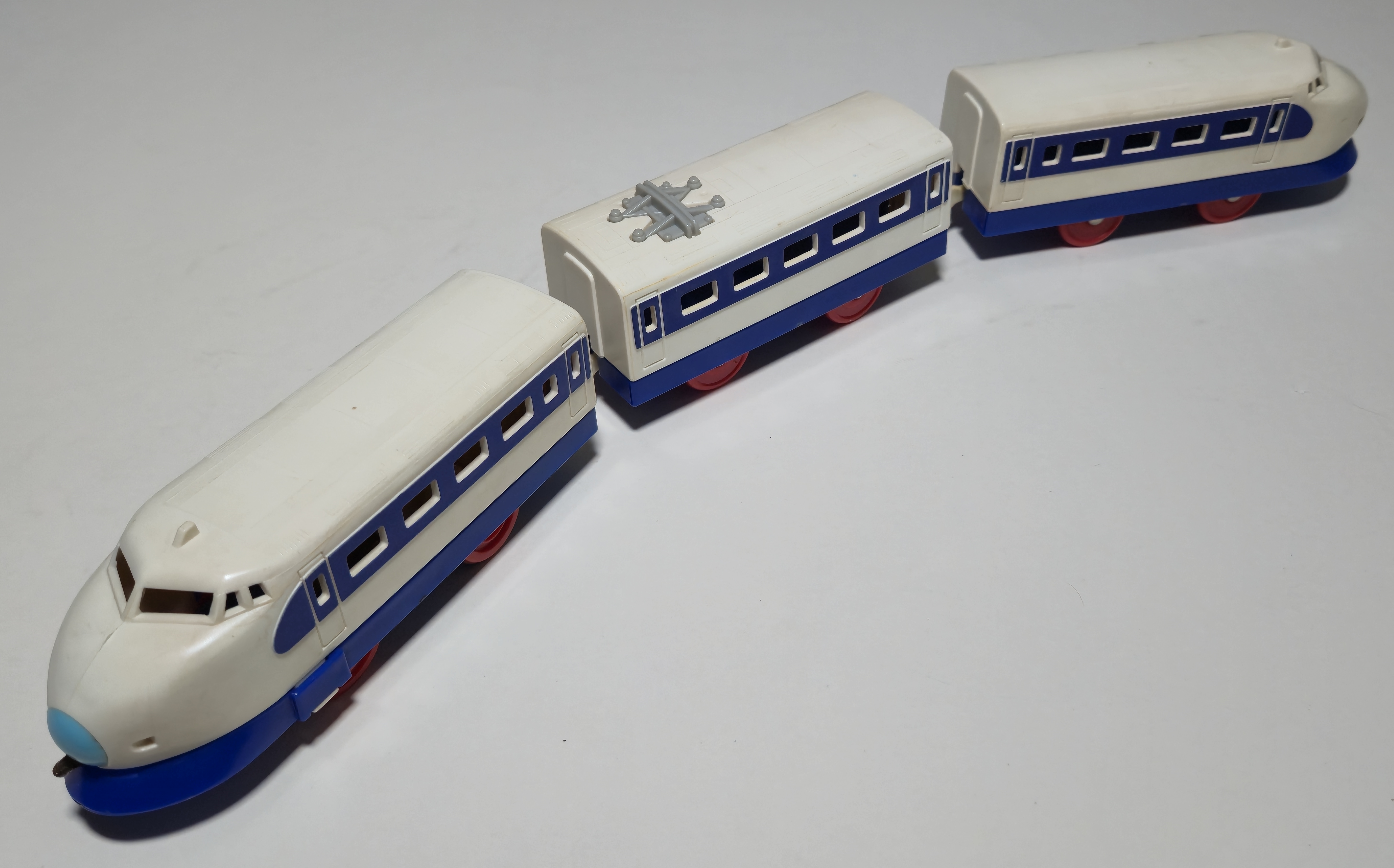
These Shinkansens have rather nice looking light blue nose cones and a redesigned intermediate car with more windows, a separately fitted gray pantograph, and the suggestion of intermediate corridors on the ends of the cars.
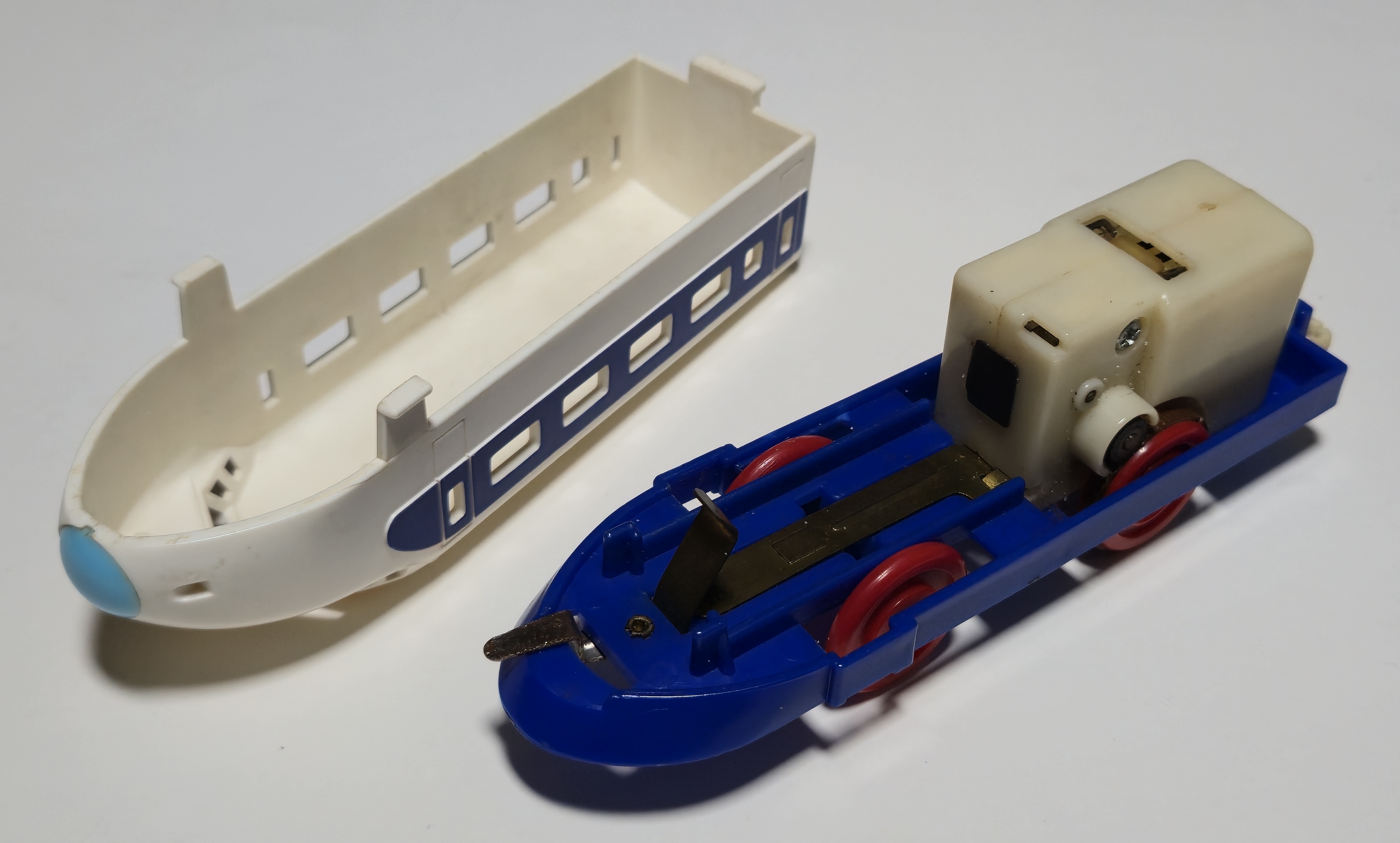
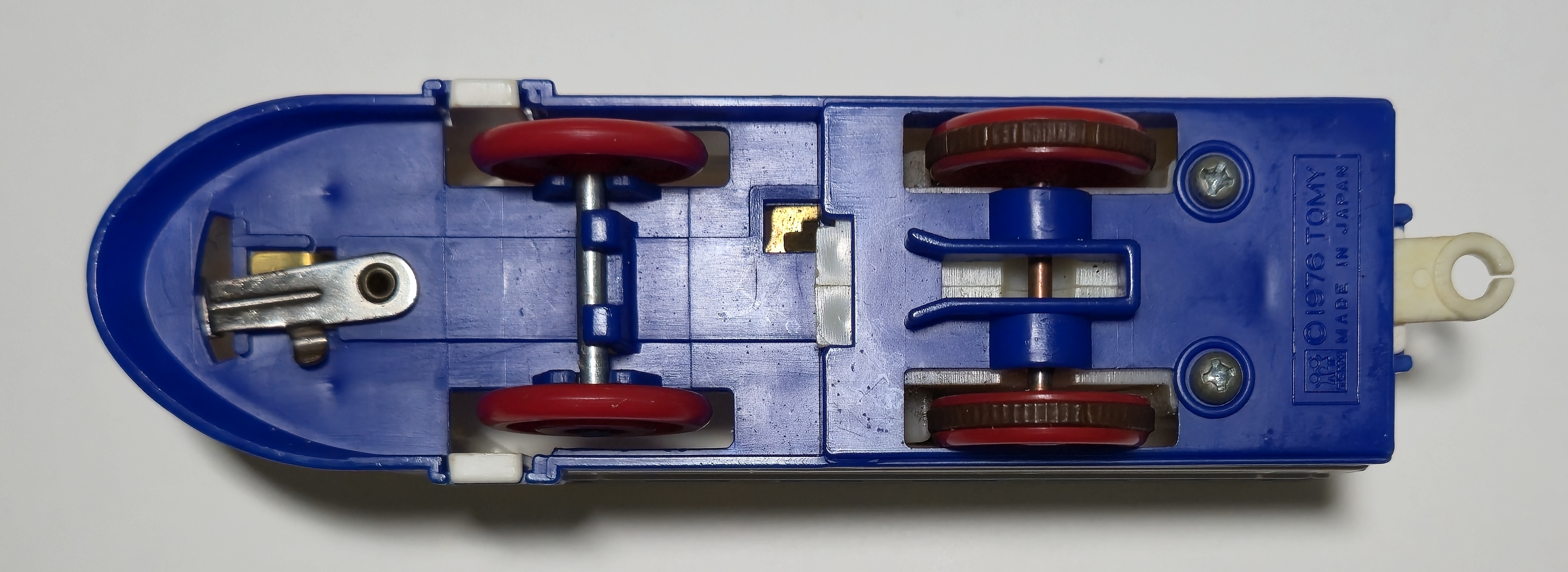
The New Hikari with its all-new toolings was designed to use the then-new milky white plastic rim-drive old-power gearbox. The power switch has moved to the front and swings the same direction as other power switches to align the range together.
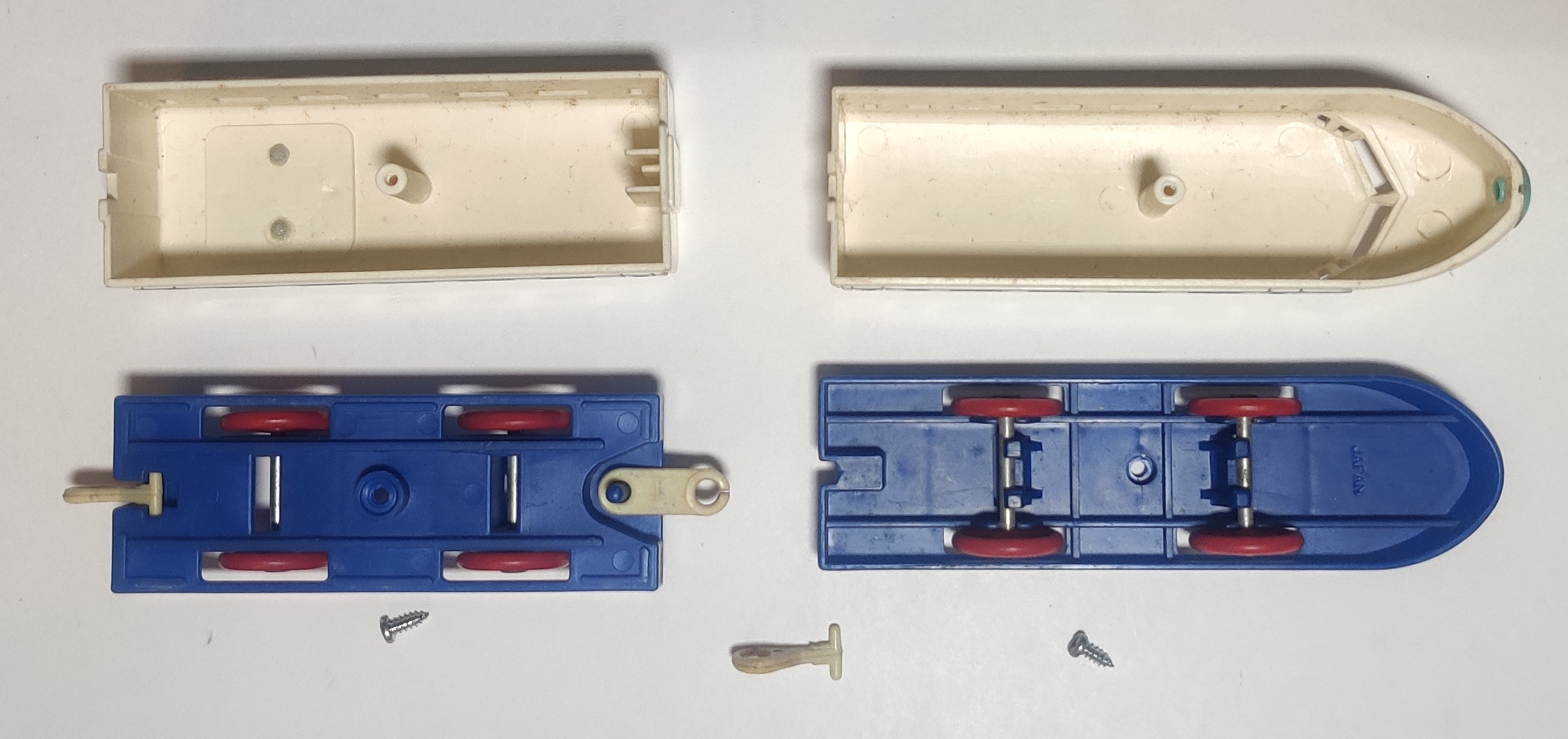
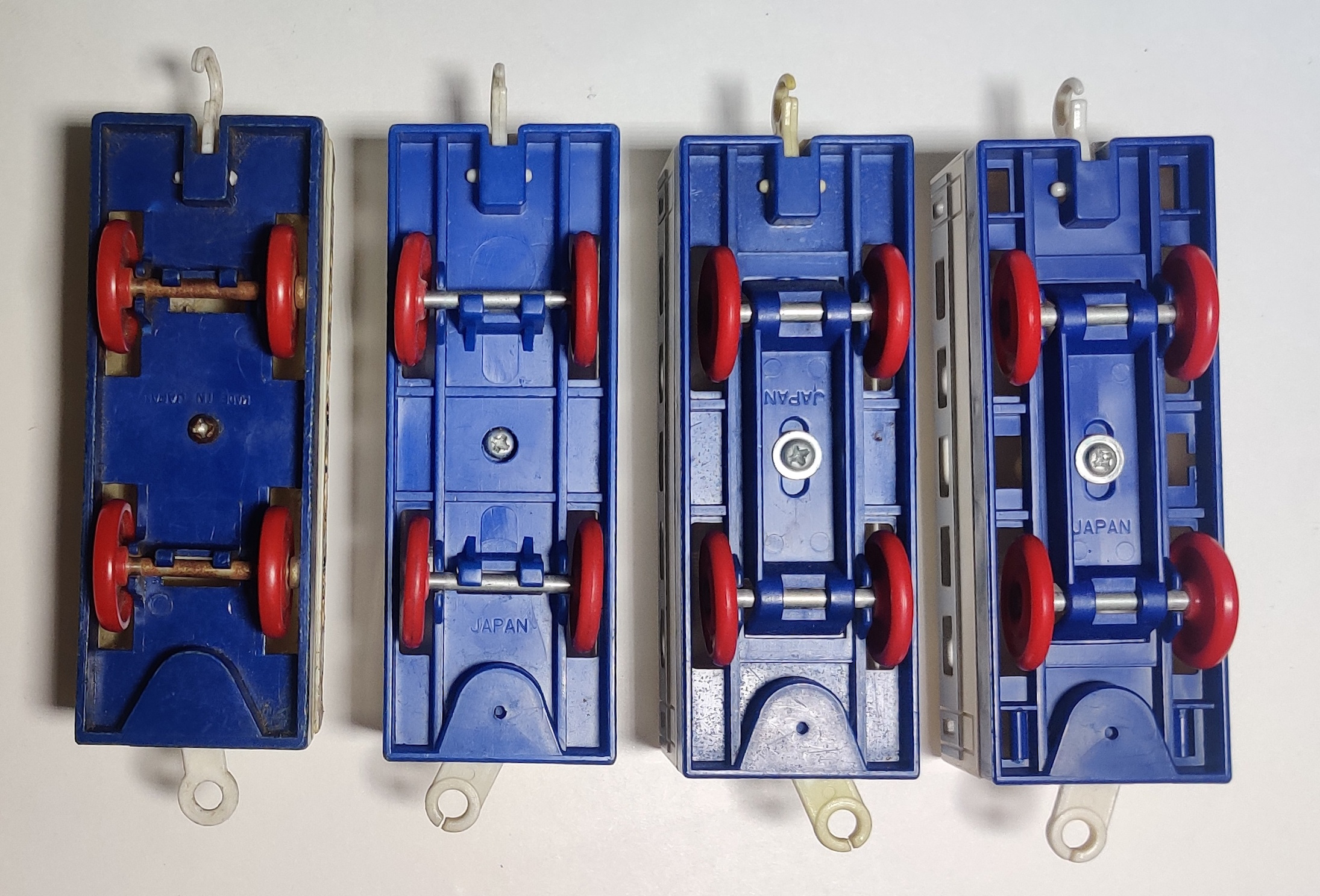
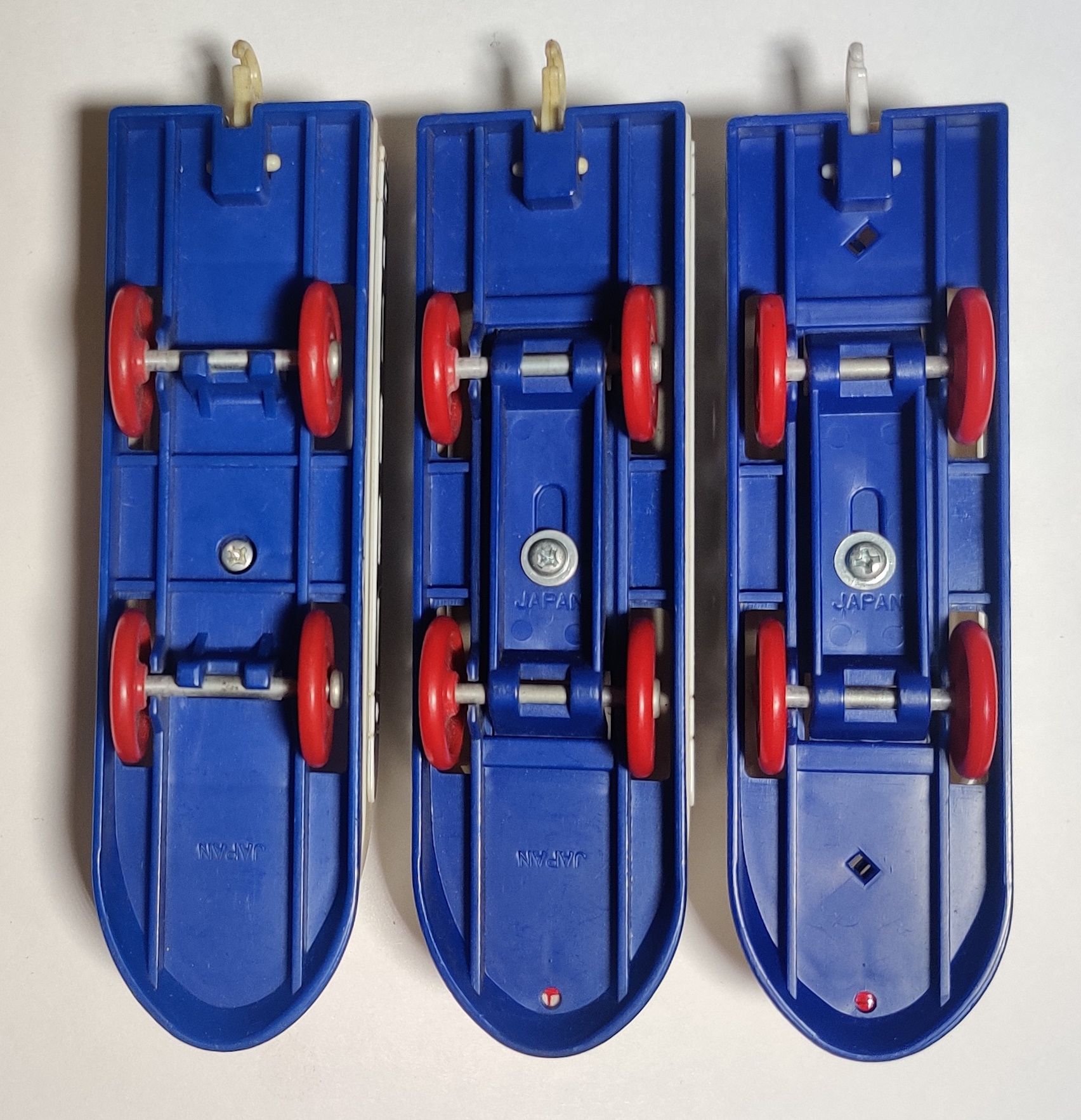
The tail and intermediate cars still use the more fragile wheel holder type which was updated in 1979 for the Hikari with Light. Shown to the right is the bottom of the earlier 70s intermediate car shown above as well as intermediate and tail cars from the New Hikari and early and mid 1980s (post-Radio Control Plarail) Hikari with Lights.
EC-01 Hikari (1978)


In 1978 the Hikari box changed from the fourth generation "train" box style to the fifth generation "EC" box style, with the regular blue-nosed EC-01 Hikari remaining on sale alongside the new-for-1979 Hikari with Light into 1980 before going out of print. Later examples included in the Double Track Automatic Station Set have darker pantographs and small blue plastic "lights" fit into the indents on either side of the blue nosepieces (seemingly because the Hikari with Lights had already started production and that version had red inserts in the headlight position to match its red translucent nose). The New Hikari and its new chassis, gearbox, and intermediate car was the basis for the Hikari with Light that became the basis for later Shinkansen variations like the 200 series, early new power Shinkansens, and some Doctor Yellows.
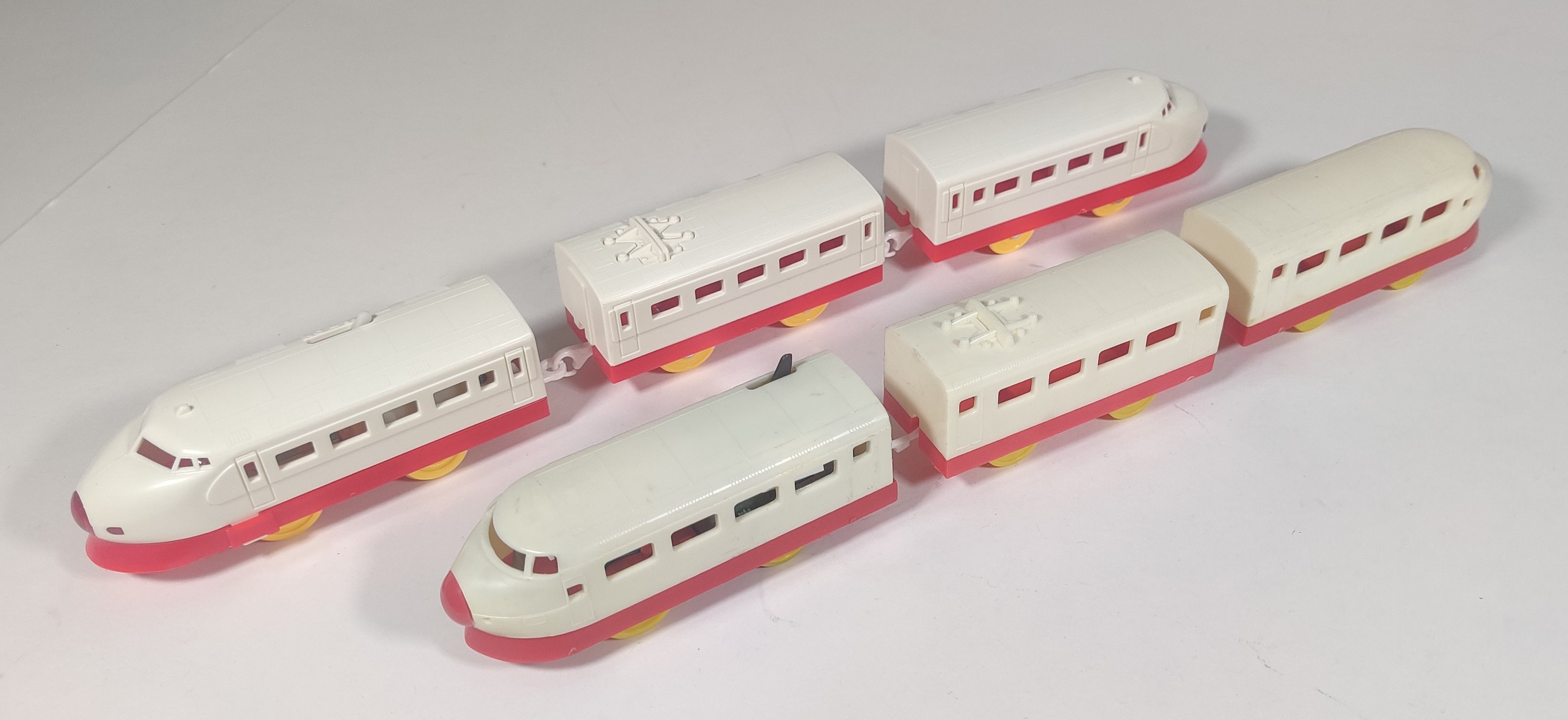
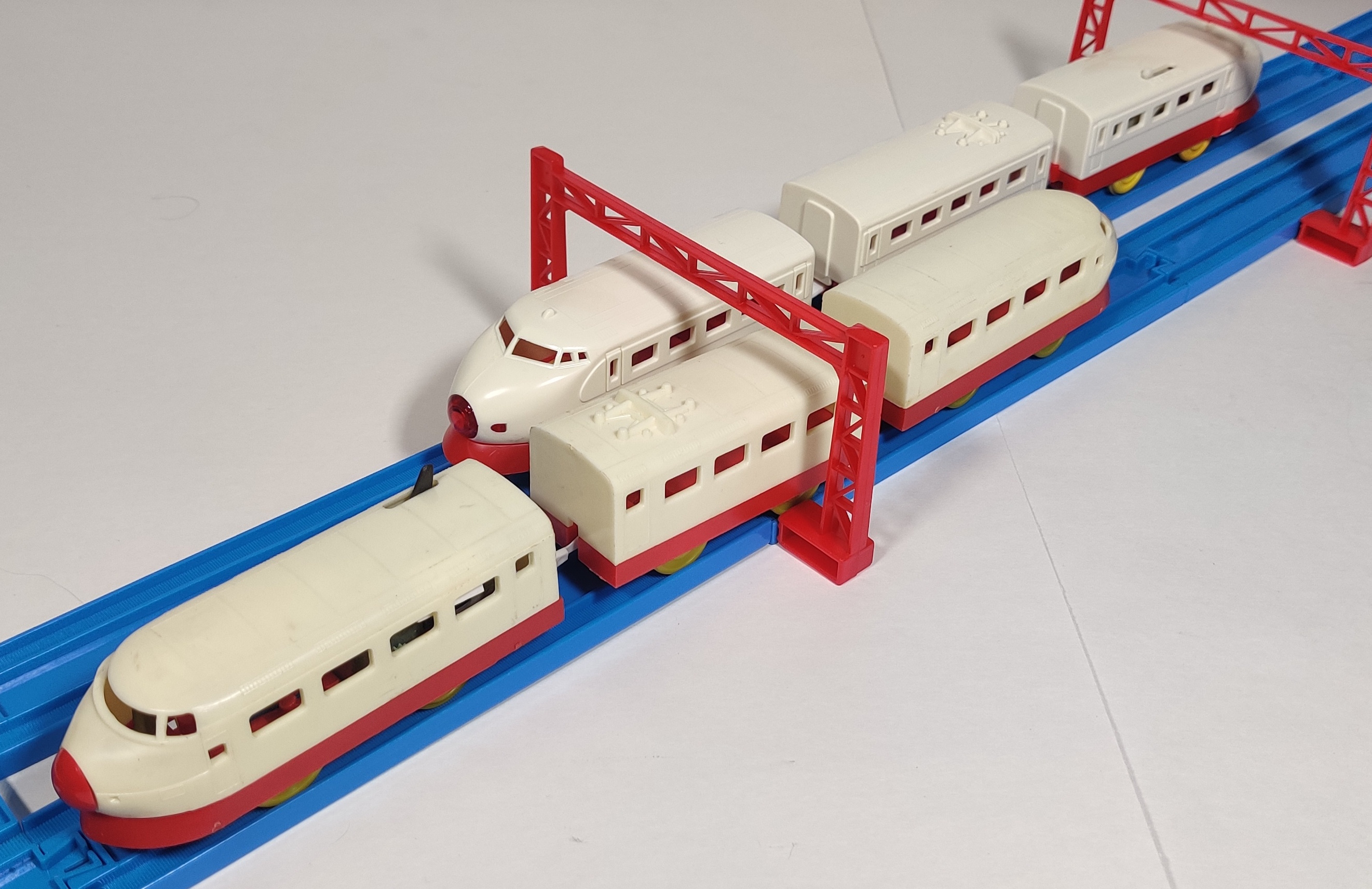
In 1999 the old red and white Hikari was reproduced in the Let's Play With Parents and Children!! Shinkansen Set which included the then-current 500 Series Shinkansen as well as the period new power 0 series tooling produced in the red and white style of the classic Hikaris, representing the type of Plarail that the then-current Plarail generation's parents might have played with.
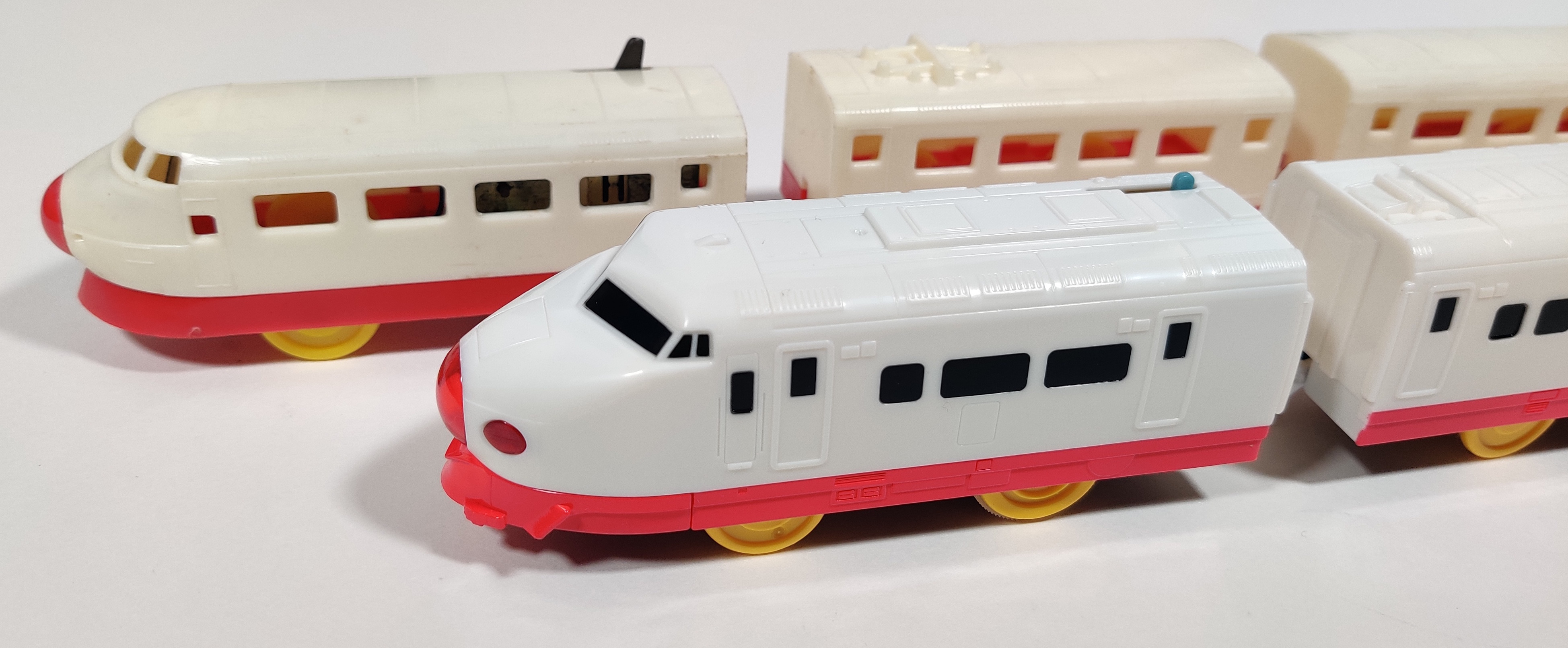
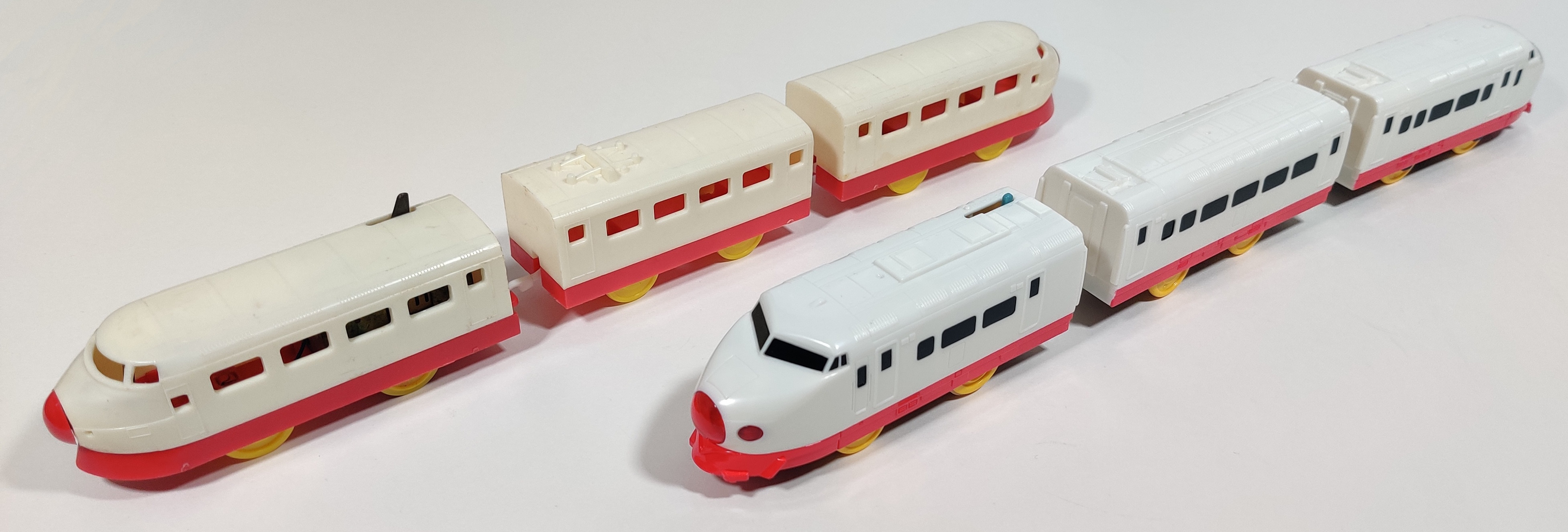
As part of the 60th anniversary of the Shinkansen in 2024, Tomy released the Shinkansen 60th Anniversary Commemoration 0 Series Shinkansen Hikari 1 & Super Express Hikari Set double train set with a modern red and white 0 series using the updated chassis and body toolings alongside a realistic blue and white 0 series train representing the first 0 series train in service.